65 Contemporary Kitchen Design Ideas for a Modern, Functional Home

Are you dreaming about a cozy and stylish place that is both functional and modern at the same time? Getting curious about how a contemporary kitchen design can uplift your home? In the rest of this article, I am discussing how some of the popular kitchen design trends of today look great and function smartly at the same time. Whether you are looking for inspiration to completely remodel your kitchen, or trying to make small changes to modernize your kitchen, I am outlining the most important elements to consider in a contemporary kitchen style.
A beautiful kitchen design must also be practical. From high-end statement lighting to smart appliances, even minimalistic surfaces, every contemporary kitchen design element impacts its form and functionality. Here is a curated list of impactful design ideas, and I’ll justify why each serves as an essential building block to your ideal kitchen.
Streamlined And Sleek Contemporary Kitchen Concepts
A contemporary design kitchen is efficiently streamlined, balancing well between convenience and class. All throughout this layout, crisp facing, concealed hardware, and integrated appliances reign supreme. Whenever I have the opportunity to give my input, I suggest utilizing a monochromatic palette, or blended soft neutral tones with shiny metallic accents. With simplicity as the guiding pillar, everything is done in a manner where order is maintained—resulting in a calm and uncluttered atmosphere.
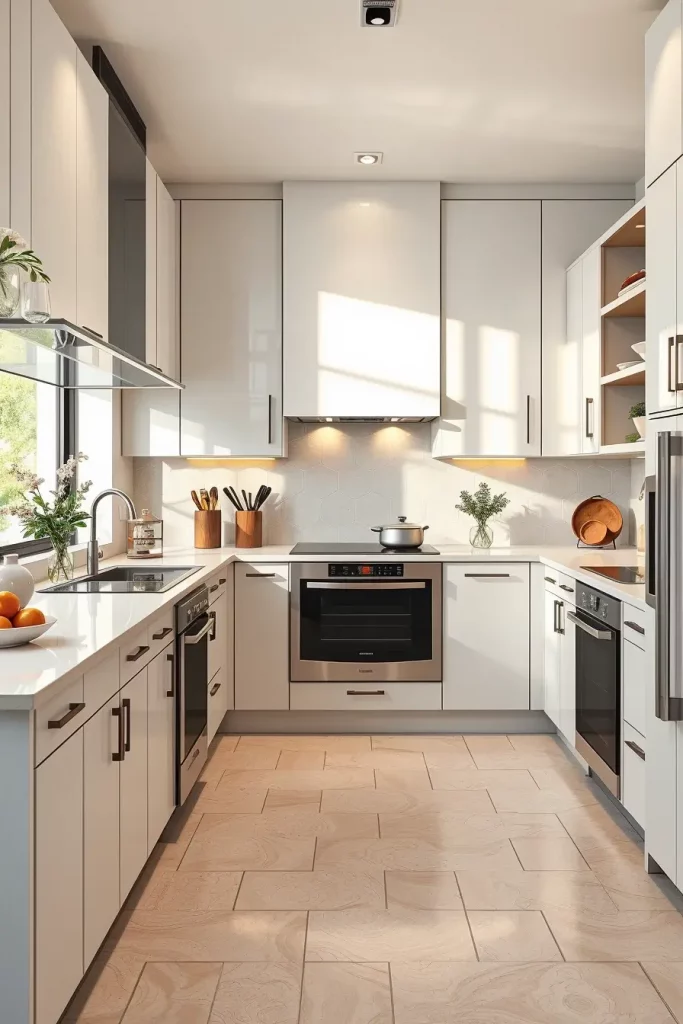
I like to begin with the installation of handle-less slab cabinets that are integrated with built-in refrigerators, under-the-counter fridges, and visually uninterrupted ovens. Finishing touches include a flush-mount light as well as low-profile range hoods for the remaining open space. When selecting countertops, I prefer quartz slabs, as they can withstand the test of time and help the room appear polished. Every detail is equally important, thus the aesthetic and the functional need to merge seamlessly.
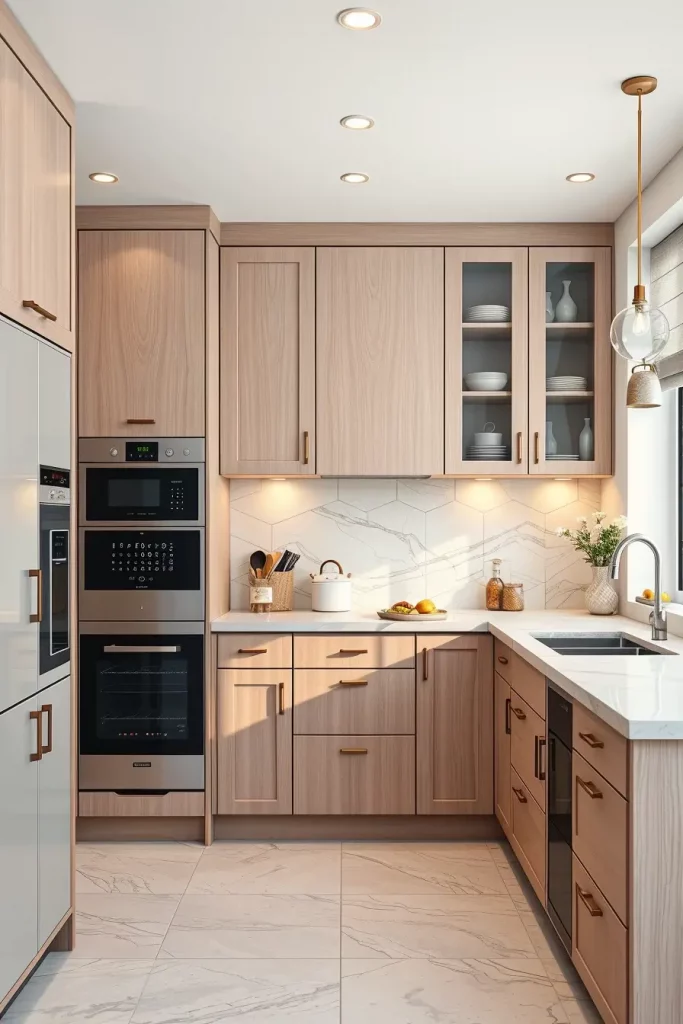
As an example, Architectural Digest noted the best sleek kitchens as ‘visual sanctuaries’ where free-flowing beauty and functions combine without excess. A calming atmosphere is especially beneficial in open-plan residences. That perfectly aligns with my design philosophy.
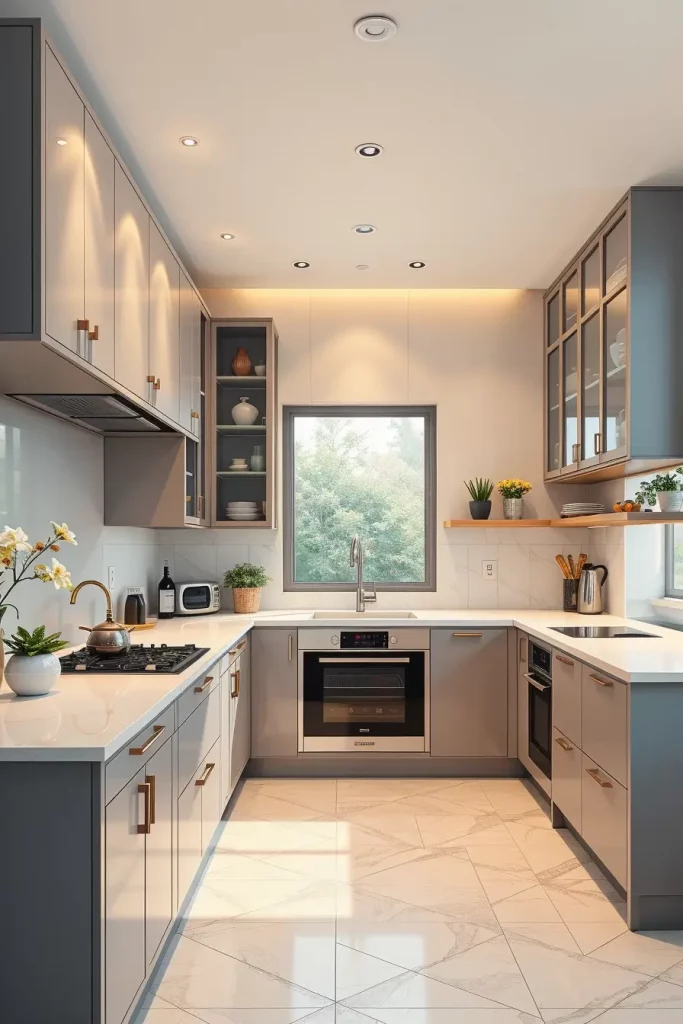
For added effectiveness, I would propose button latch cabinets, as well as matte-finished appliances for effortless touch aesthetics with improved usability.
Maximally Impactful Minimalist Kitchen Designs
In my works, I prioritize streamlined cabinetry, open counters with unobstructed views, and free of clutter spaces. A minimalist kitchen strips down to only necessary elements, focusing exclusively on form and function. A clean, spacious room where everything is organized is made possible by the lack of visual clutter. Minimalism eliminates distractions, allowing for focus on the statement pieces.
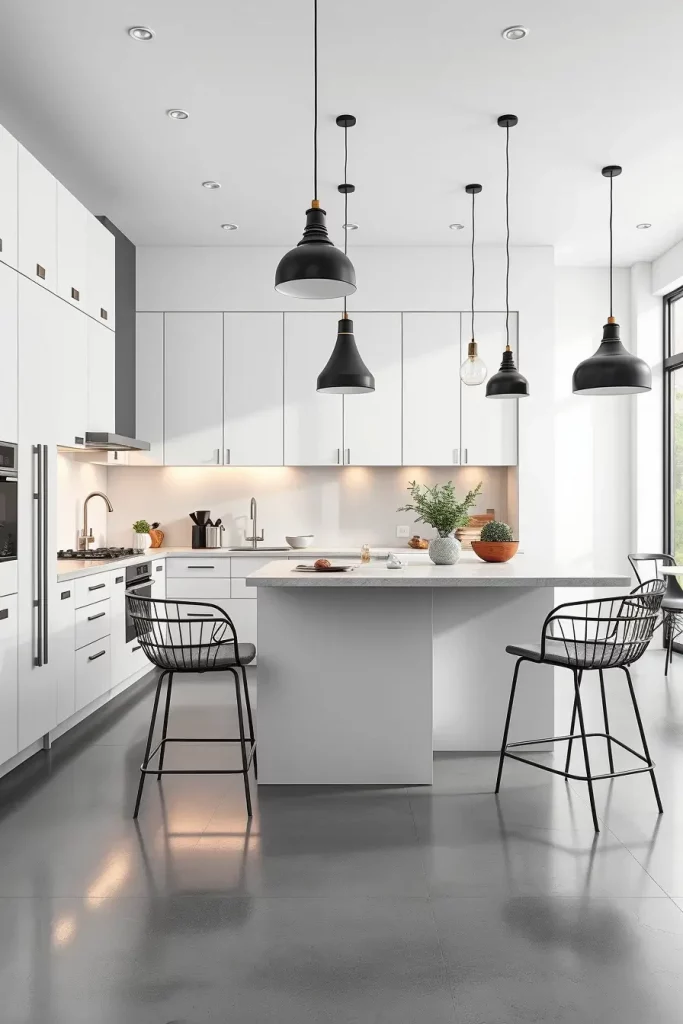
For the furniture, I prefer using flat panel cabinets in solid colors such as white, gray, or black. The induction cooktop, recessed handles on the cabinets, and push to open drawers all blend seamlessly with the minimalody feel of the space. It is common for me to choose bar stools in molded acrylic or molded steel with streamlined profiles. She added, “Minimalist doesn’t mean boring; the secret is in the texture. Matte cabinetry. Concrete-look surfaces. Fluted wood panels.”
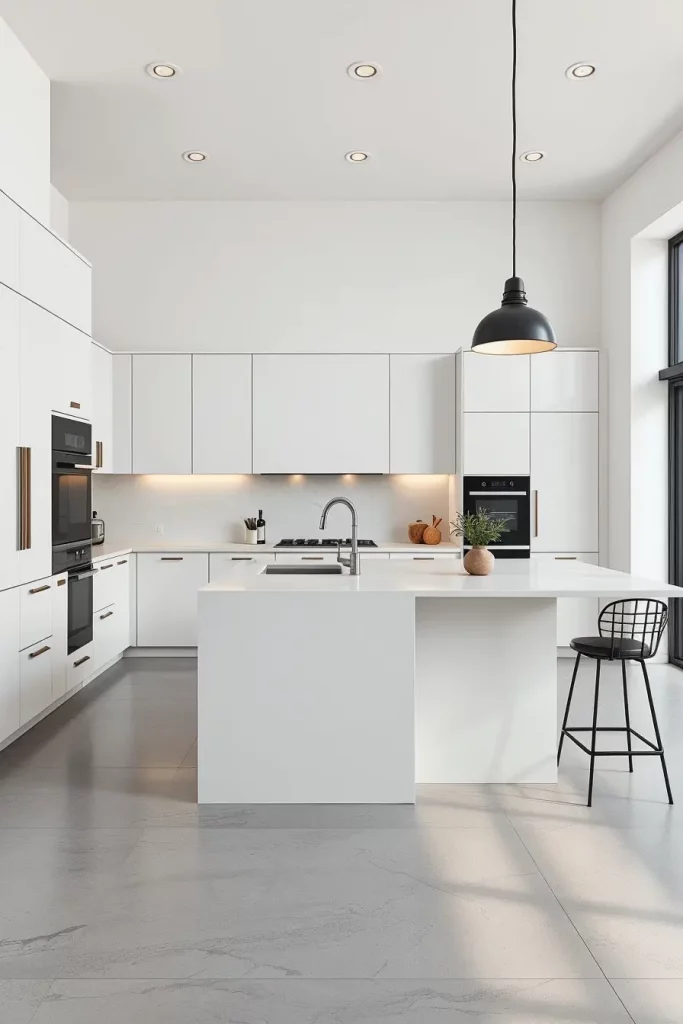
Minimalist kitchens seem to be very adaptable, especially in smaller residences. They give off an organized appearance while expanding the feeling of space. Elle Decor mentions that the absence of excessive ornamentation also contributes to intentionality in lifestyle, which is something I admire and try to integrate into every design.
To this section I would add flaps with built-in compost drawers or hidden knife storage with sleek counters for added ease of access and elegance at the same time.
Open Concept Kitchen Layouts For Modern Living
An open layout design maintains the connection of the kitchen to the rest of the home, which in modern households is often the most used space. This style of design eliminates partitions to enhance connection and interaction. I encourage all my clients who want their kitchen and dining or sitting areas to naturally flow into each other to adapt this style.
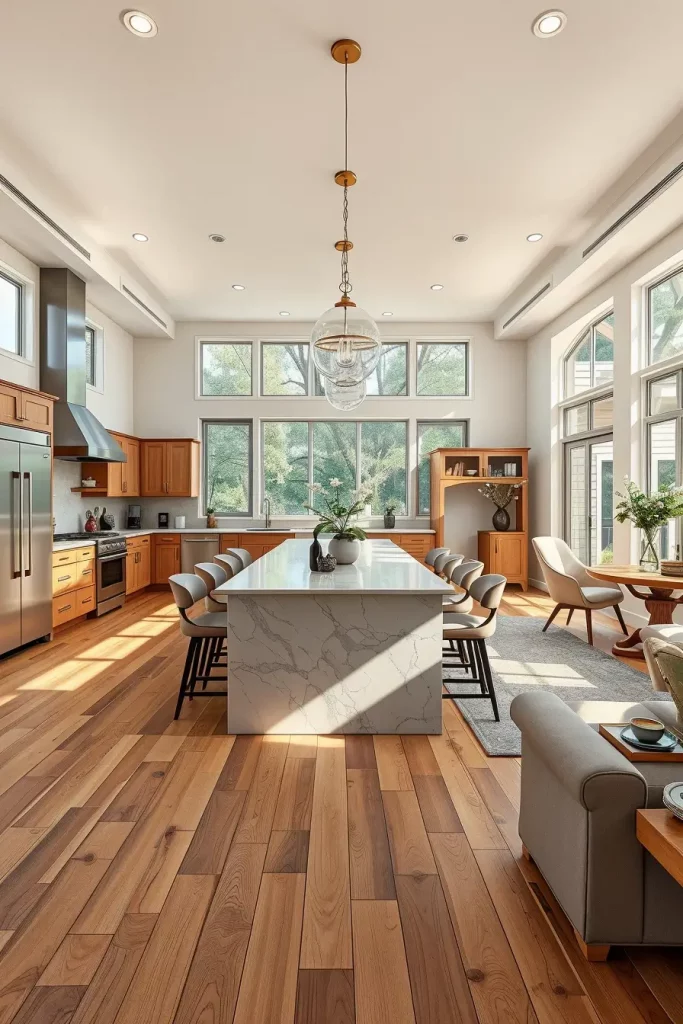
For the layout, I like to place a large island as a transitional element between the kitchen and the rest of the spaces. Low-profile bar seating, pendant lights, and mistakably simple cabinetry all contribute to a better overall flow. Uniform flooring across spaces also contributes to cohesion. To modernize a room, I windowpane or use wood.
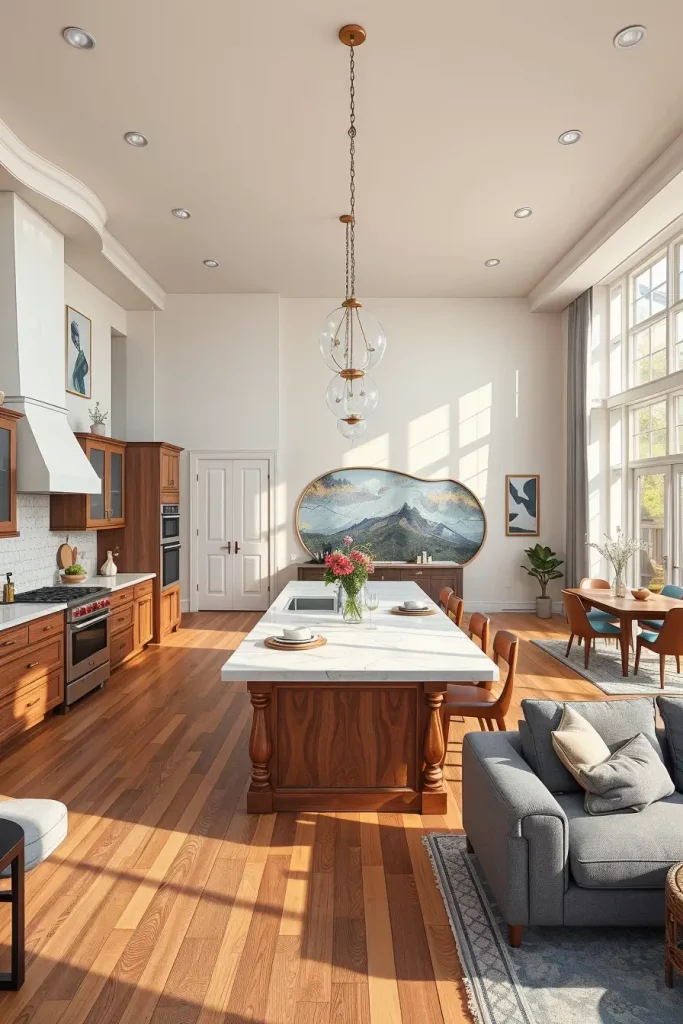
In my experience, an open layout encourages family connection and multitasking. When prepping dinner, you could help your kids with their assignments and be able to actually socialize with guests too. The designers over at Dwell often argue the open-style kitchen embodies the ‘sociable home’ and I couldn’t agree more. It’s a concept that closely radiates my design aspirations.
If some degree of separation is required from time to time, I recommend sliding or retractable glass partitions. It provides a balance between privacy and openness.
Color Psychology – How Neutral Tones Foster Warmth
In contemporary kitchen design, neutral shades serve as the building blocks and the reason why they create a consistent backdrop where the materials and architecture pop. My go-to color schemes include light gray, light taupe, soft white, and black. These shades exude a timeless and sophisticated look while making the area feel open and spacious.
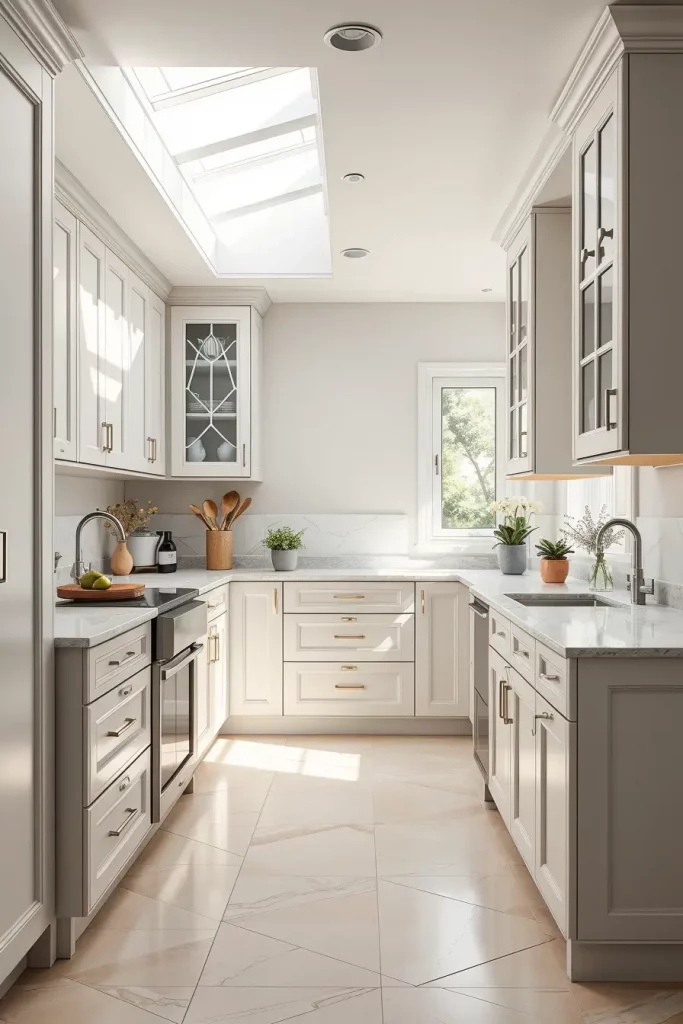
I typically pair upper cabinets in white with deep gray or matte black base cabinets to create depth and contrast. Countertops in marble or quartz provide understated visual interest. To warm up the space, I like to add brushed nickel or matte brass hardware. Even accent items such as dishware, planters, and rugs are selected in soft tones to avoid raucous discord.
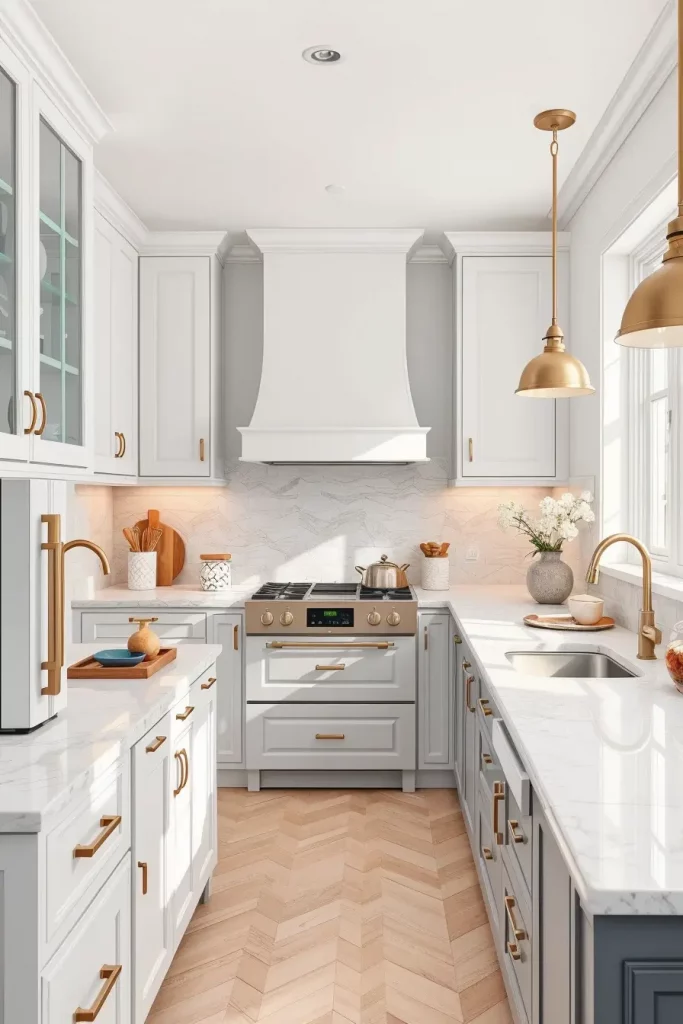
I find that most of my clients appreciate soft neutral colors. These hues are particularly useful in visually busy households. House Beautiful regularly shouts about the mental wellness advantages of neutral interiors, and I have to say, I agree.
In some of my projects, I’ve had an urge to add more character with a pop of color like a blue backsplash or green island but only if these would fit well into the overall design dominated by neutrals.
Integrating Smart Appliances Into Kitchen Spaces
Smart appliances are leading the way in the evolution of technology within contemporary kitchens. New innovations such as touch-screen refrigerators and wi-fi equipped ovens add convenience and energy efficiency. I tend to design with integration in mind so that these devices don’t disrupt the appliances’ visual symmetry within the kitchen.
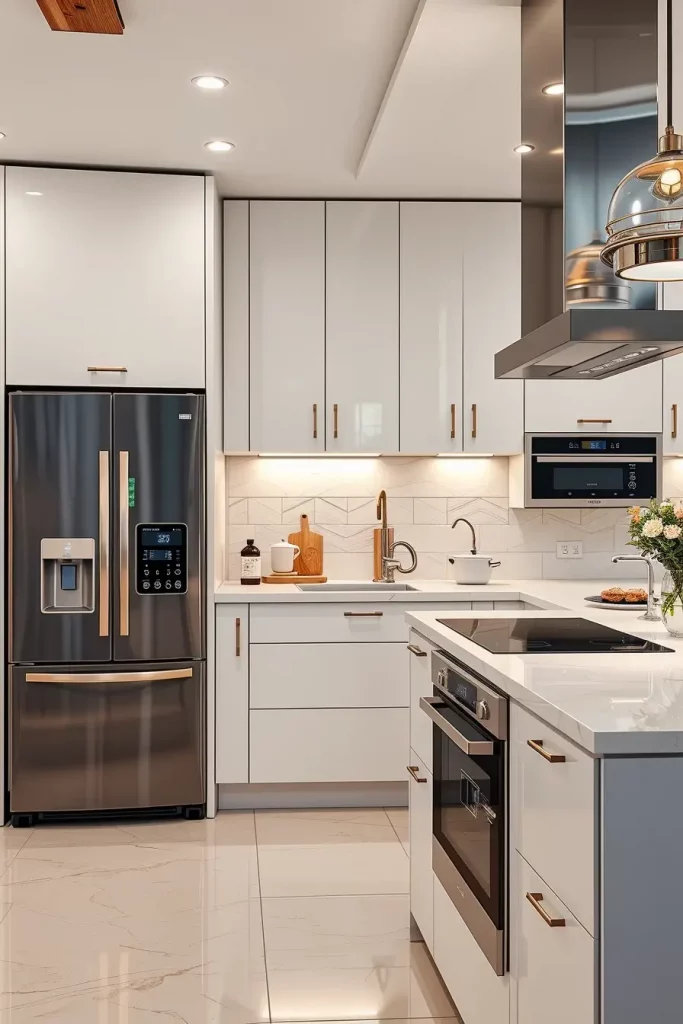
Naturally, I opt for built-in appliances with panel-ready finishes to maintain a polished aesthetic. Smart lighting systems, induction cooktops, and even voice-activated faucets are rapidly becoming staples in my designs. Touchless trash bins and a concealed charging depot help out, too.
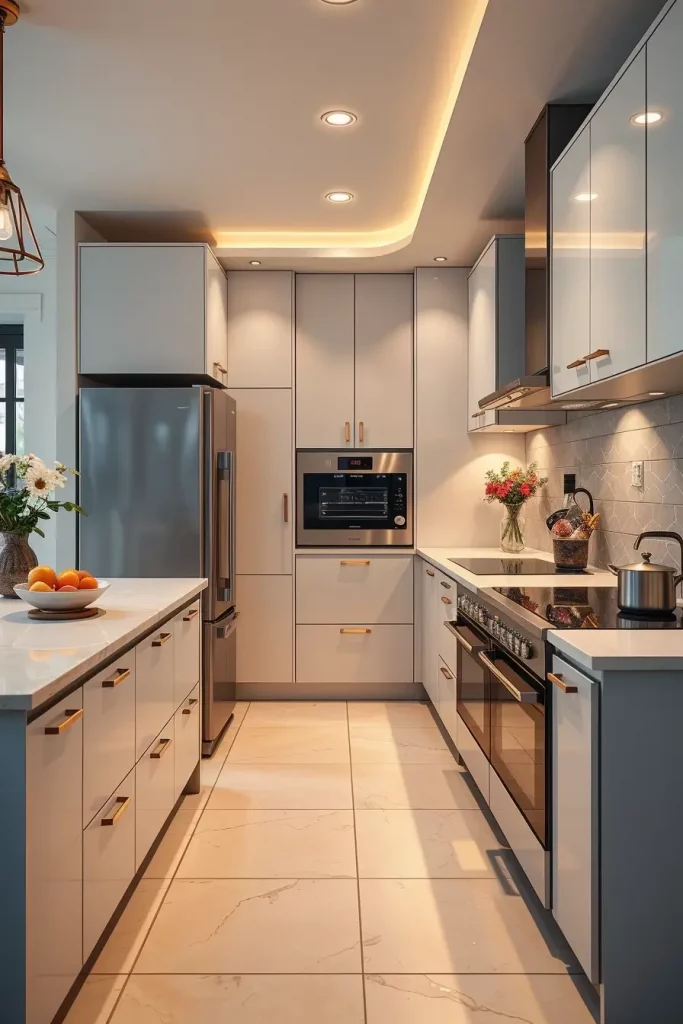
It’s far more convenient to have a smart fridge that sends notifications when groceries run low, and in my case, my family means fewer trips to the supermarket. Forbes Home states that smart kitchens can increase property value and provide a “future-ready” level of adaptability, which enhances value. That’s something I focus on with my clients.
To further elevate the experience, I’d suggest synching climate control or a smart integrated speaker system.
Luxury Materials That Elevate Modern Kitchens
When looking to infuse contemporary kitchens with a touch of luxury, I reach for fine materials that expertly combine visual appeal and strength. Marble, natural quartzite, exotic woods, brushed metals and similar luxury materials are timeless, and have the added bonus of being conversation starters in any home.
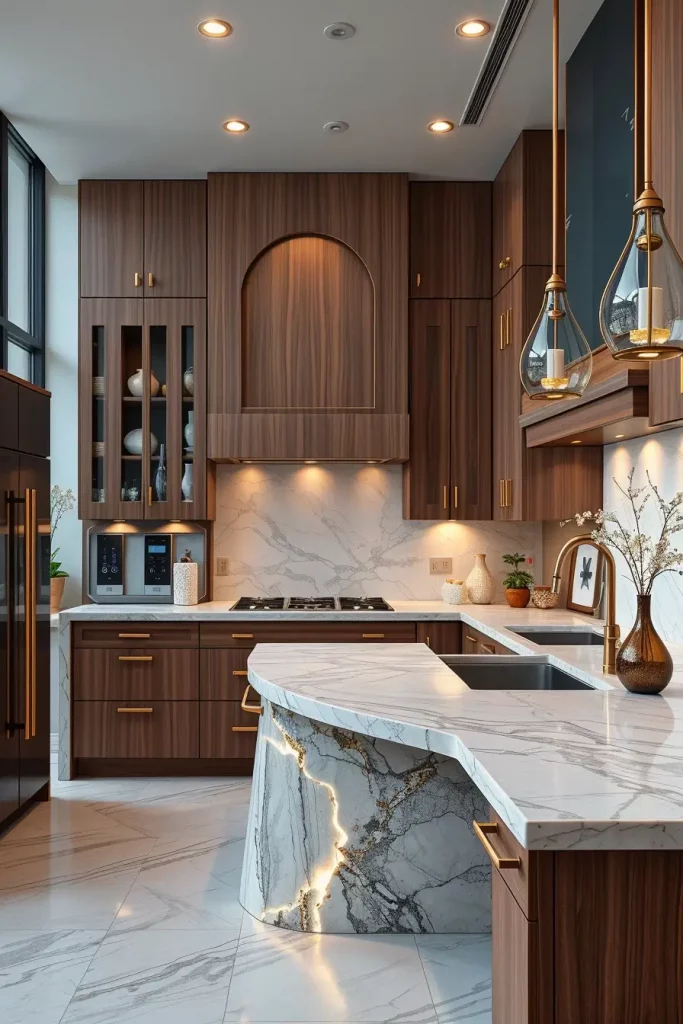
It is common practice to recommend a waterfall island of marble and accompany it with cabinets in high gloss walnut or oak. For bronzes accents and touches, I apply champagne or bronze—they introduce some warmth. A textured mother-of-pearl or marble mosaic backsplash makes the area come alive without overpowering the space.
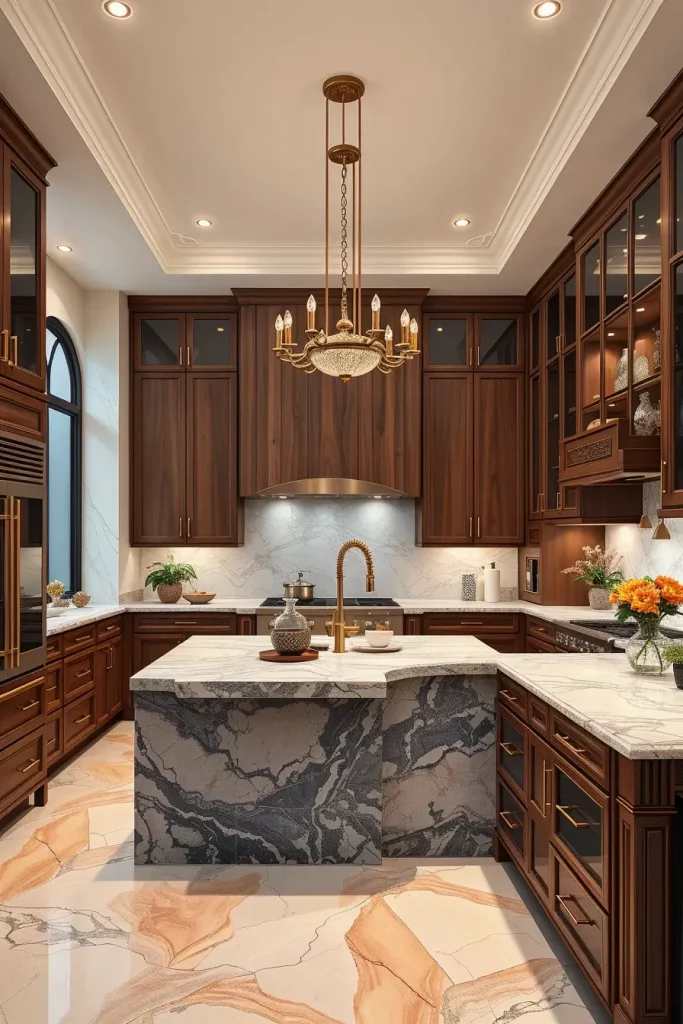
Quality of material can completely shift the feeling of a space. Clients are always blwon away by the combination of depth and rich texture that these materials offer. Tailored kitchens is how Veranda magazine refers to them, and I couldn’t agree more.
To achieve the most refined impact and truly high-end designer look, I would also suggest adding honed finishes and bookmatched slabs.
Kitchen Design With Clutter-Free Storage Solutions
What’s one of the biggest hurdles you face in the kitchen? For any kitchen, the most difficult tasks to navigate around are staying on task. With contemporary kitchen design, attaining a clean finish free from dead space is the goal—but accessibility is a priority, too. With my designs, these intelligent stowed systems work behind the scenes.

In my plans, I often include full-height cabinets with pull-out drawers, vertical tray dividers, and deep pantry pull-outs. Kyelo, sl kitchen drawers placed at the base of cabinets or floors skirting drawers, corner lazy susans, and built-in organizers for cutlery or spices are staples in my layouts.
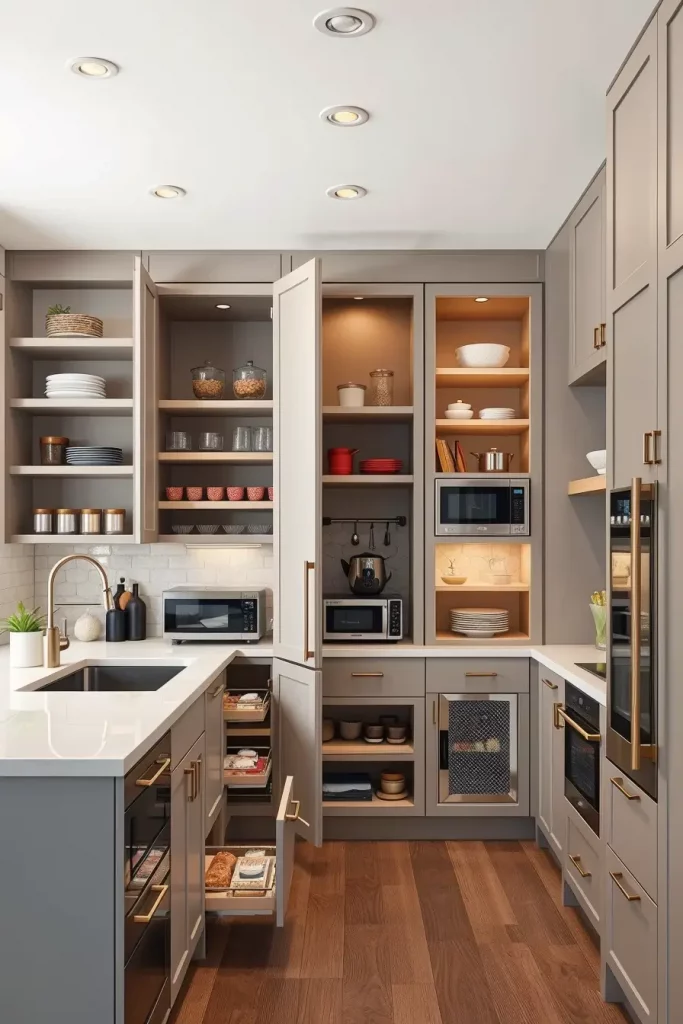
In my opinion, a well-kept kitchen always seems more luxurious and easier to work in. Clients with smaller kitchens also appreciate how good storage makes their space feel larger. Better Homes & Gardens claims that good storage is “essential to function and flow.” I agree with that in every consultation that I do.
To improve this concept, I would add concealed appliances and labeled interior bins to enhance usability and aesthetics.
Waterfall Kitchen Islands For Primacy
Out of all the features that you can add to a contemporary kitchen, waterfall kitchen islands poses to be one of the most enticing. The sculptural effect that the countertop “flows” down brings to the room is captivating and underscores clean geometry, an invaluable principle in modern design. It serves as the primary design consideration of free kitchens.
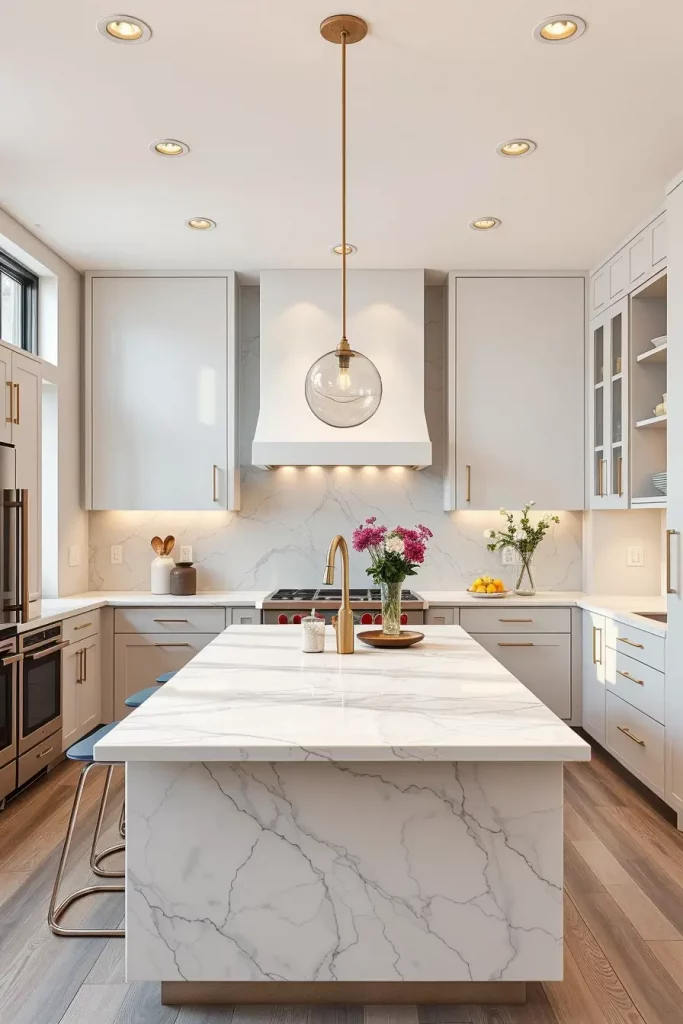
I prefer materials with class such as white quartz, marble, or even concrete due to their durability. To enhance the functionality of the island, I will often add kitchen covers, built-in drawers, remote power plugs, and cabinets deep beyond the counter face. The visibility of these elements creates sleek aesthetics uninterrupted by visual chaos. This spills to be paired with backless bar stools or acrylic bar seating.
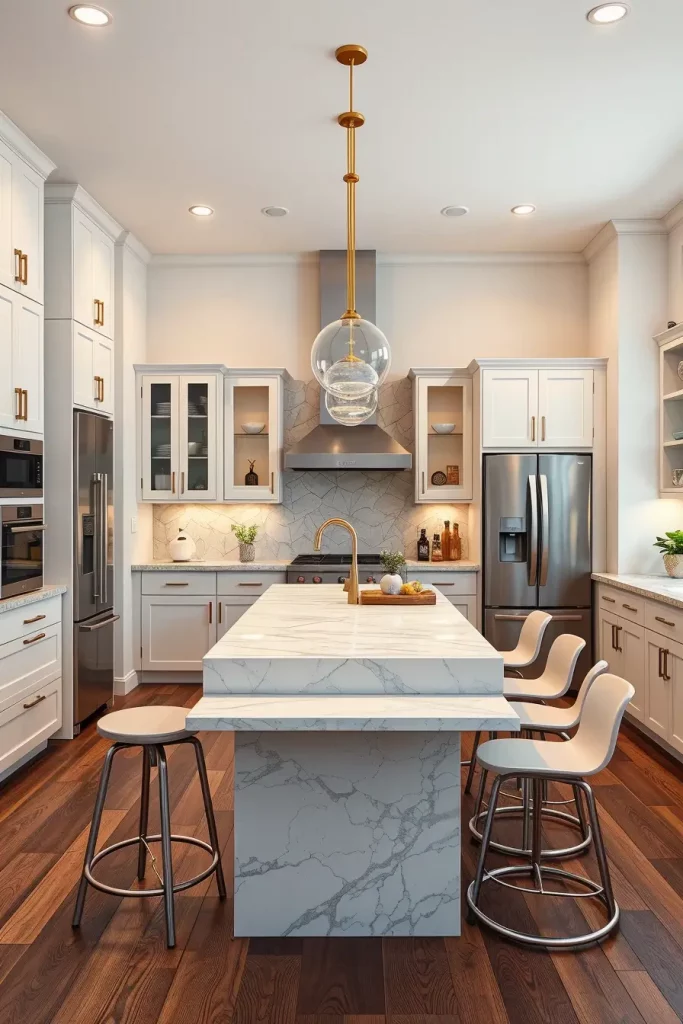
The waterfall island tends to be particularly responsive to form and function, taking a kitchen’s workspace and turning it into a centerpiece. This is also how Arch Magazine propels its tone of waterfall mounts instantly igniting architectural interest as the centerpiece for most kitchen makeovers I’ve had the chance to partake in.
For enhanced refinements, concealed compartments for recycling can be omitted too.
Matte Finishes And Surfaces In Contemporary Kitchens
Modern kitchens have been transformed by the introduction of matte surfaces. I find myself using matte finishes the most since they create a softer atmosphere by absorbing, rather than reflecting, light. In a world dominated by glossy surfaces, matte surfaces provide a fresh welcome relief. Whether one’s taste is towards charcoal black or muted sage, matte textures blend in beautifully with almost any color scheme.
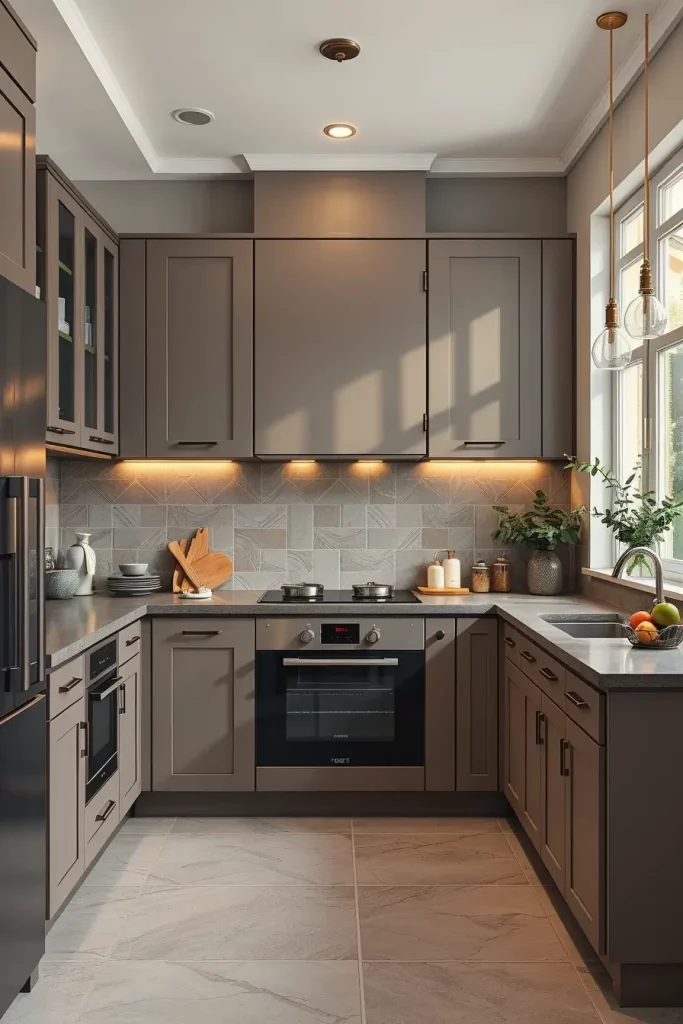
Some of my favorite go-to combinations are taupe or graphite matte cabinetry accentuated with brushed metal cabinetry. Their velvety feel makes concrete and soapstone to be some of my favorite go-to choices for matte finished countertops. These cohesive choices along with backsplashes in matte ceramic tile and low sheen wall paint add depth to every surface in the kitchen while reducing glare.
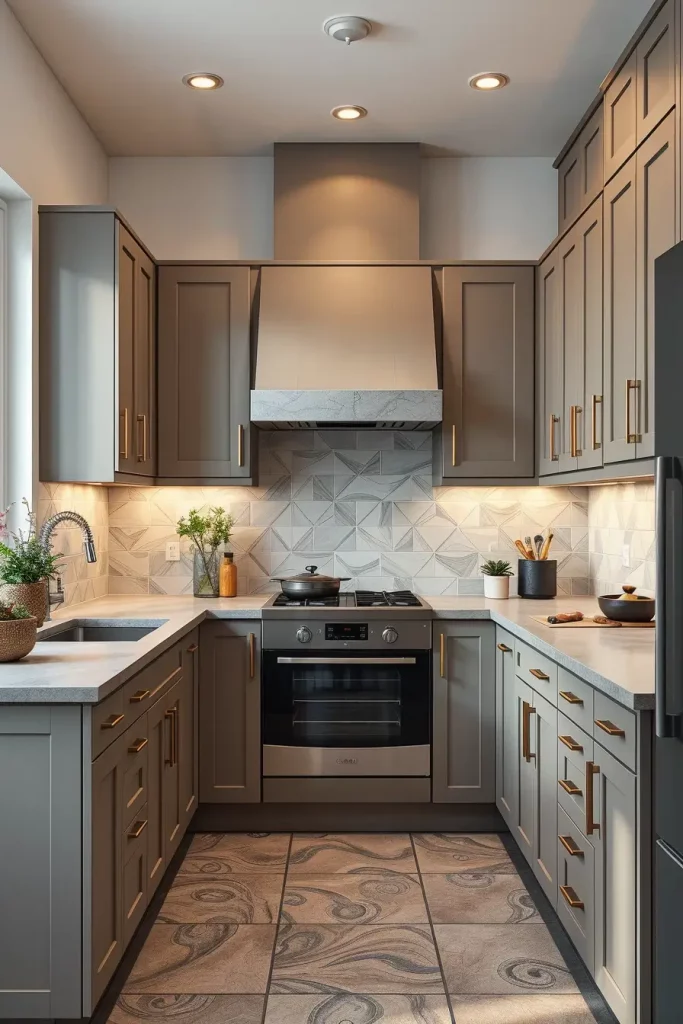
Matte surfaces seem to age better with time, in my experience, and don’t reveal fingerprints or smudges which makes them easier to maintain. I fully agree with HGTV’s claim that matte finishes add understated sophistication to spaces in which they are used.
To further this concept, I would add matte black plumbing fixtures or pendant lights with a matte finish to the mix.
Lighting Styles That Make a Statement in Any Interior
Depending on its design, the kitchen can dominate the mood of a contemporary household, especially with regard to its lighting. Having every pair of lights placed is not enough; treat lights as a functional piece of art and blend the sculptural qualities with all other pieces of the kitchen. Right statement lighting enhances the charm of the decor with sufficient focus placed on the art of illumination.
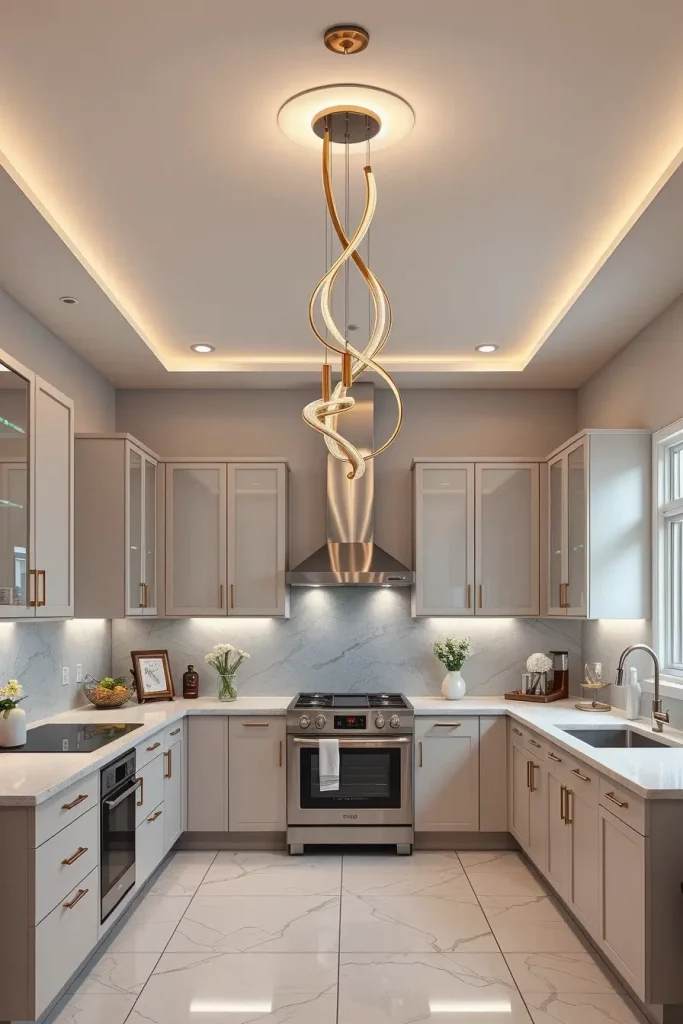
Some of my personal favorites are sculptural chandeliers or oversized pendant lights suspended from the island stools, even linear LED lights concealed onto the cabinet. While brushed brass, matte black, or frosted glass typically lends itself to the latter, I am also a fan of layered lighting.
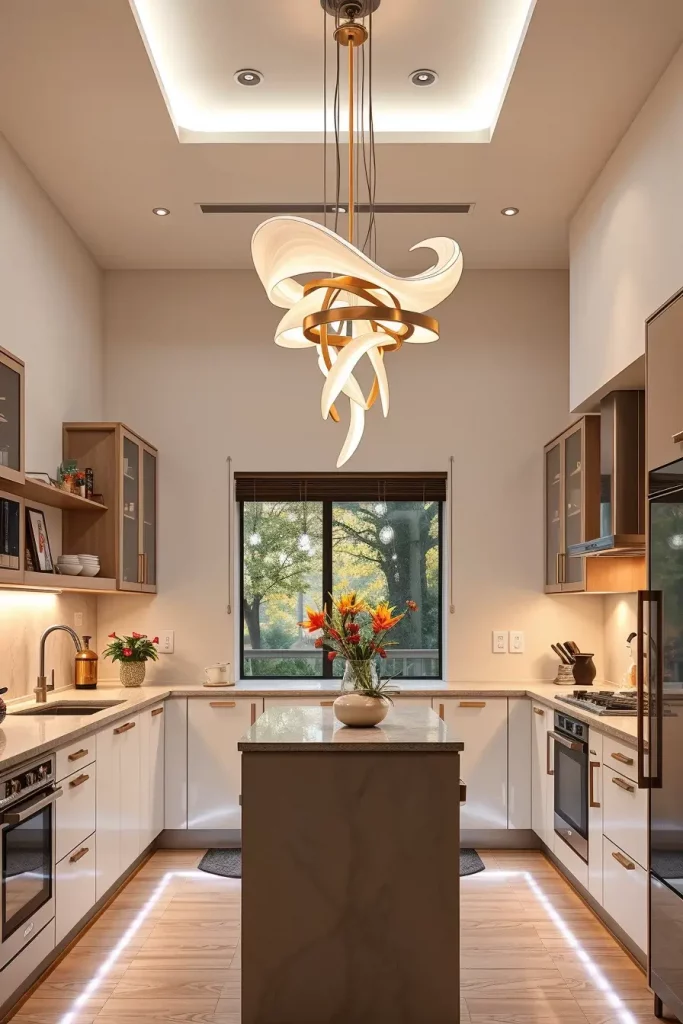
Dark pendant lamps or polished globes serve to give off flattering soft focal lighting, soft ambient lit like concealed bay lighting add atmosphere, and frosted shop lights give work lighting.
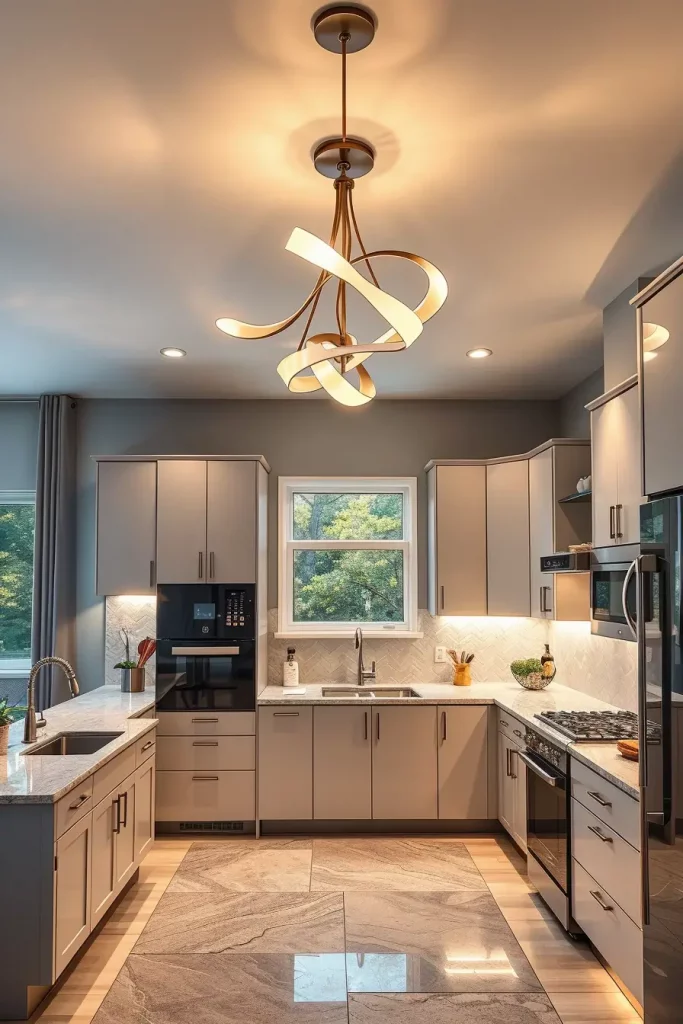
A globe style globe gives off delightful light during gatherings, and augments spaciousness with its masterfully geometric frame. What I love most about it is the ability to move it easily, even when I want to switch it off. Architectural Digest suggests that statement lights to “jewelry” in the rest of the house, but I find this suggestion highly inaccurate for other space.
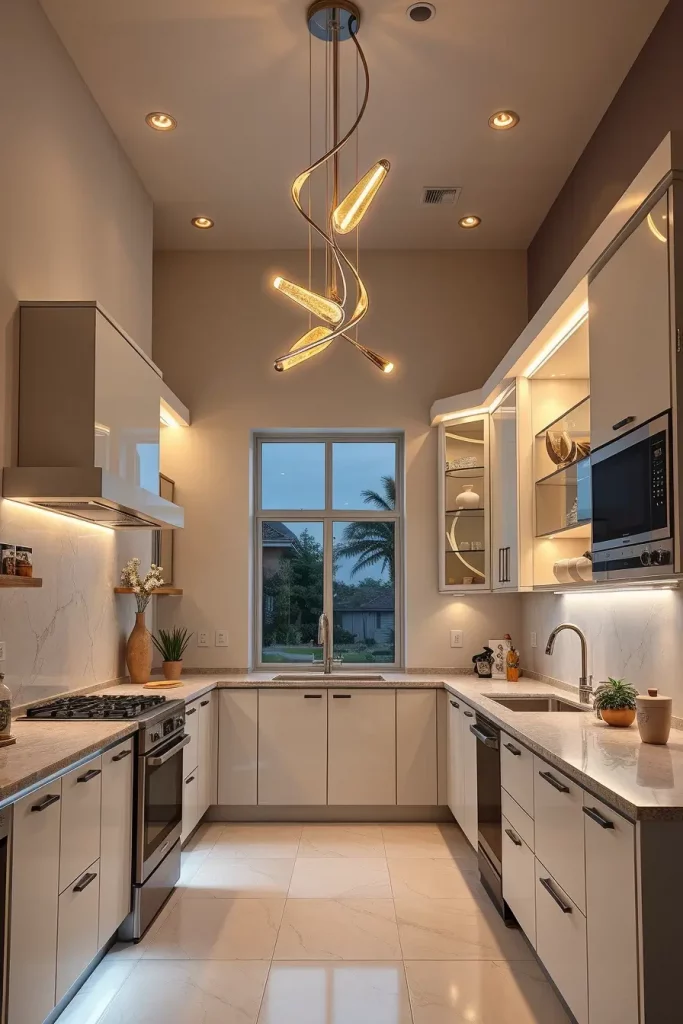
For dimming effects at unpredictable hours, adding dimmer switches alongside smart bulbs to control will change everything.
Integrating Wood and Stone Textures in Contemporary Kitchens
A modern kitchen design can be greatly enhanced by merging textures like wood and stone. I like to use these materials to soften spaces that feel too shiny or cold. These combinations add warmth and natural depth to sleek areas.
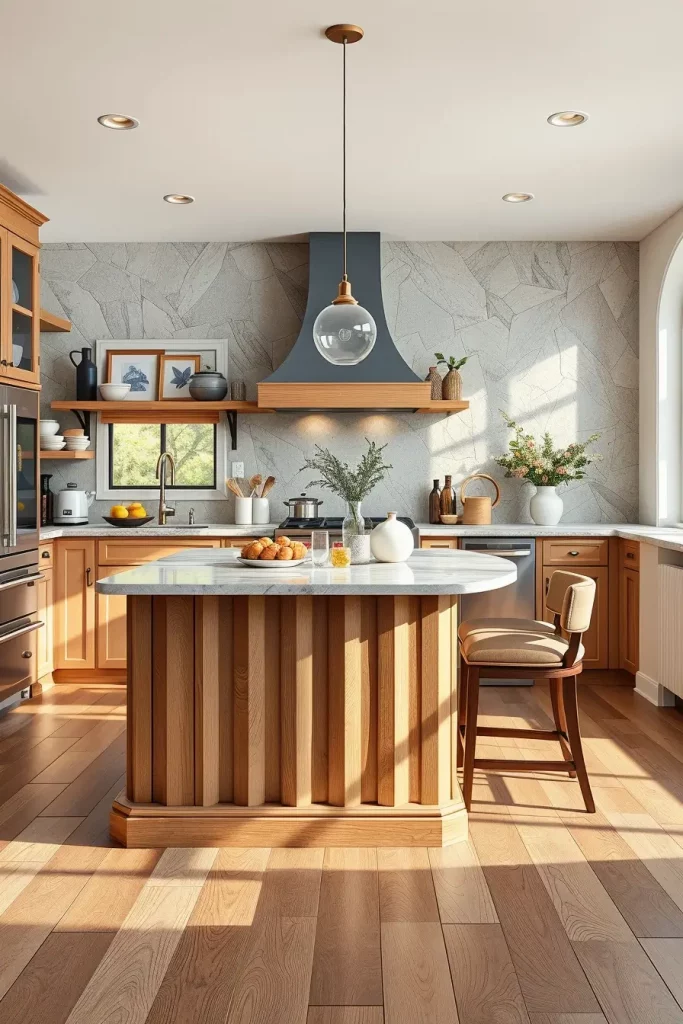
For instance, I would do a fluted oak island base with a polished marble or granite countertop. Wide plank wood floors add grounding warmth. Backsplashes in stacked stone or honed limestone bring subtle texture. Even small wood accents like open shelves and trim around range hoods make a big impact next to natural stone.
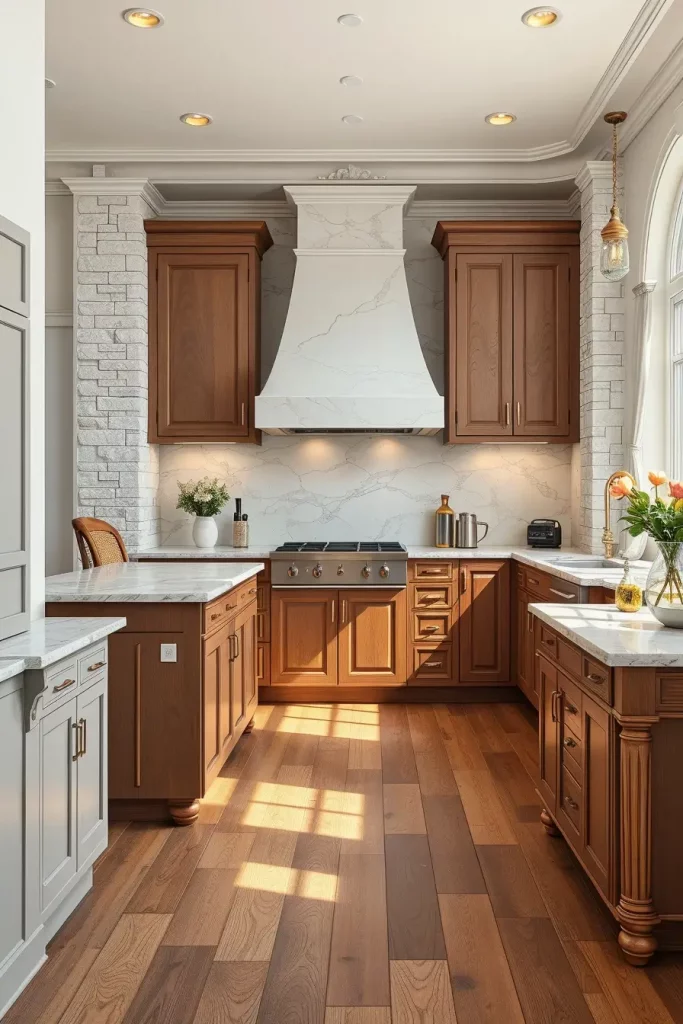
I find this combination especially useful in the homes where the kitchen needs to feel inviting but still need to make things modern. Elle Decor recommends often adding tactile contrast in order to avoid “flat” contemporary spaces. They are highly relatable to my approach when designing.
To push this idea further, I would incorporate stone look porcelain tiles or add a wood coffered ceiling detail to balance the rest of the room and enhance the tactile harmony throughout the space.
Glossary Of Cabinets And Their Reflective Appeal
While some may prefer matte finishes, glossy cabinets retain a certain charm in many modern kitchen styles. They bounce off light, creating an illusion of more space, particularly in smaller kitchens or those with limited light. I often specify high gloss lacquered or acrylic cabinets so that light may strike them and create the sleek, mirror-like effect that elevates the entire kitchen’s appearance.
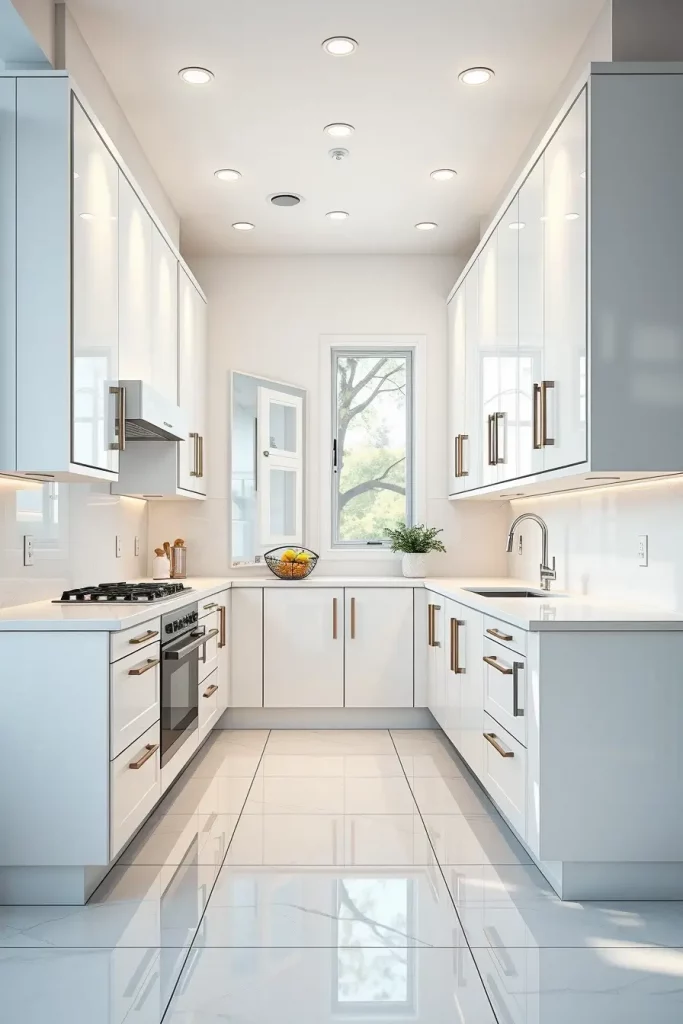
In order to achieve a smooth aesthetic, I typically style glossy white or gray cabinets with integrated handles, forming one single flat surface. When I want to introduce more drama to the space, I go for glossy upper cabinets in deep blue or burgundy while the bases are neutral in hue. These surfaces look particularly striking when juxtaposed against richly textured matte countertops or backsplashes.
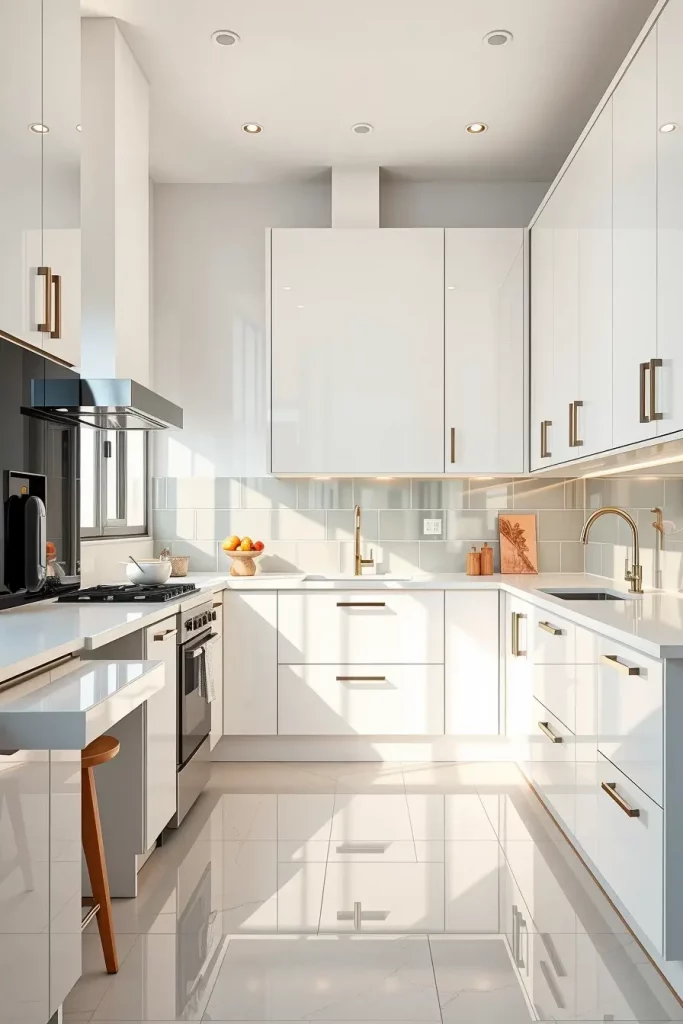
Everyone gets so fascinated with the high-end luxury glossy cabinets offer to the kitchen. Well, Better Homes & Gardens mentions that a gloss finish can give a more “spatially bold” approach to a kitchen and I can definitely say that it’s true.
If the room permits, including some reflective ceiling panels or glossy tiles for the splash would considerably increase the brightness and perceived dimensions of the area even more.
Floating Shelves For A Clean, Open Look
A contemporary kitchen design requires an open, breathing aesthetic, which floating shelves achieve effortlessly. They have become a go-to of mine instead of upper cabinets, especially in constricted areas where I want to maximize sunlight. They offer a great deal of style due to their clean construction, and their practicality is evident in their accessibility.
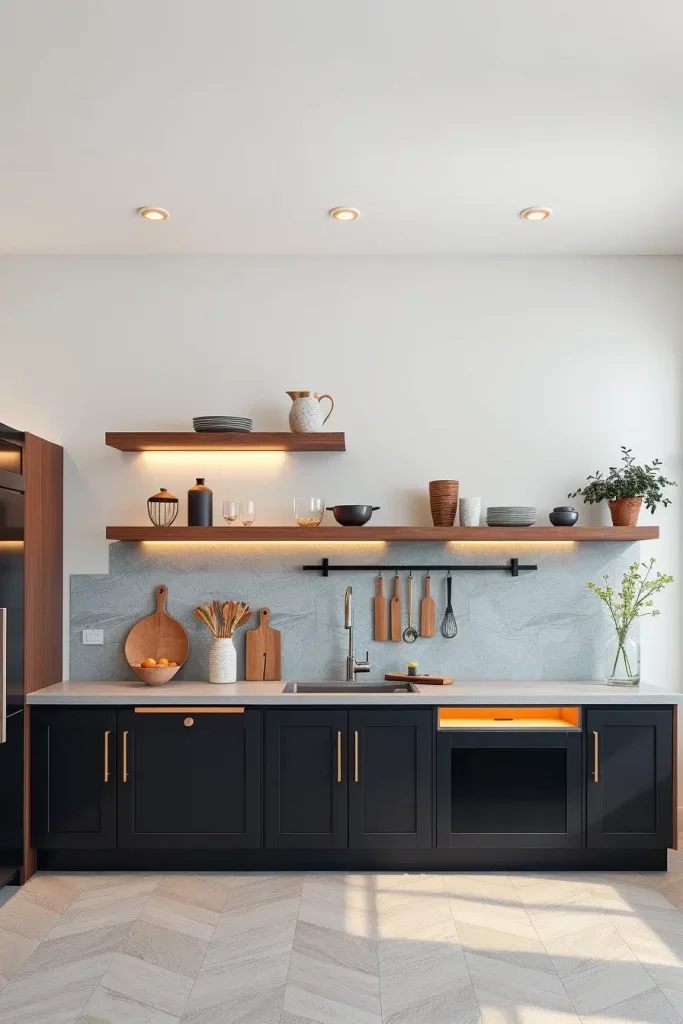
Floating shelves come in solid painted MDF, or solid wood. Shelves mounted with concealed brackets work best for displaying purposfully arranged dishware, glass jars, or decorative items such as plants and candles. Lighter oak or darker laminate cabinetry also offers wonderful options for stylish contrasts or complements to the shelving.
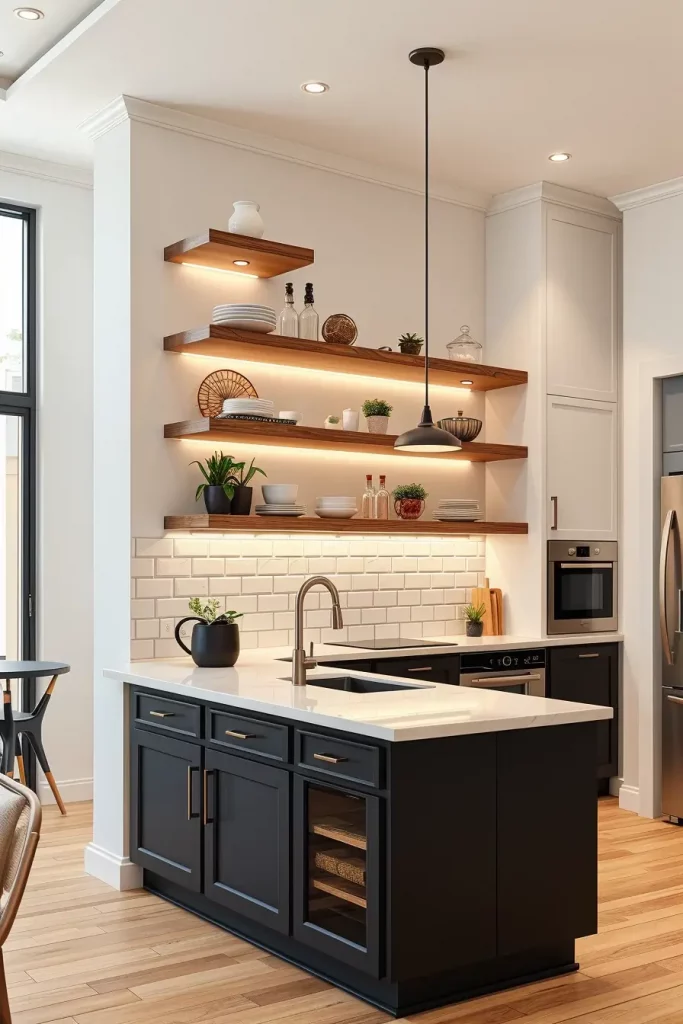
Floating shelves are perfect in the kitchen because hepling to absorb too much boxiness or closed in heaviness that might dominate the space. My experience aligns with Dwell’s perspective, which promotes open shelving for providing “visual relief” in dense kitchens. I appreciate the shelf’s space division while allowing additional display space.
To draw attention to the items and set the mood for ambient lighting in the evening, I would also integrate LED strip lights to shine above the shelves.
Kitchen Design Using Color Blocking Techniques
As a contemporary kitchen color blocking is one of the architectural approaches to kitchen designs where shapes can be constructed using complementary solid vivid or contrasting hues. In elevating a kitchen’s aesthetic, I use color blocking to demarcate areas, draw attention to specific features, or even showcase elements of personal style in a minimalistic design. It is an inventive method to add vivacity into the space without overpowering its tranquility.
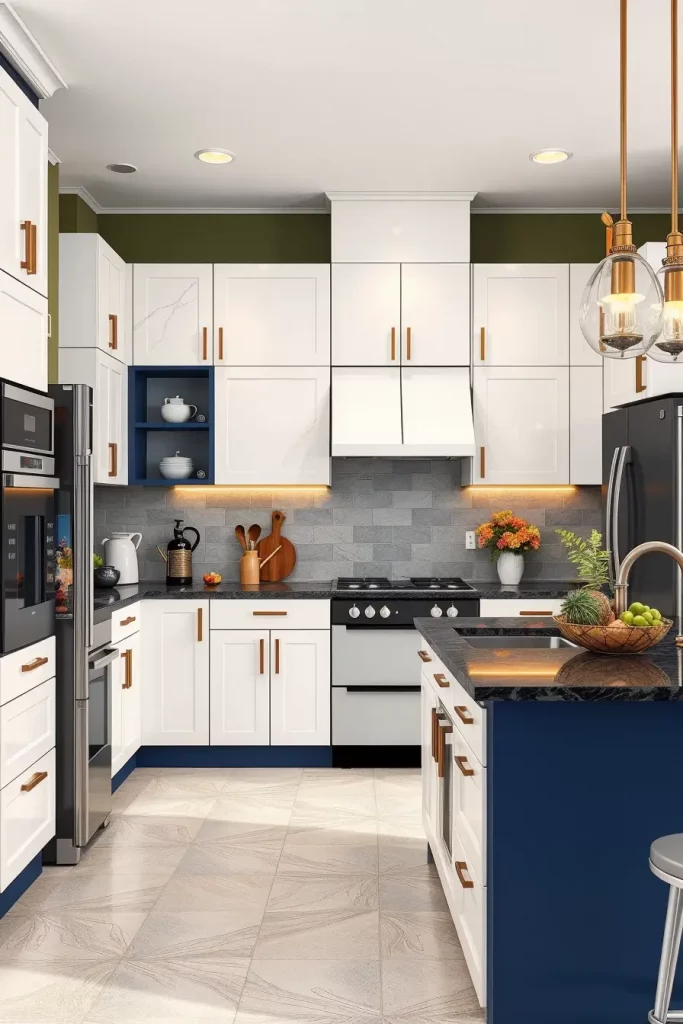
I frequently use warm white for the upper cabinets while the deep navy blue is utilized for the lower cabinets. The focal wall can be accent olive green while the rest of the area remains muted. Touches of contrast can also be found on the islands and countertops such as black granite commercials white cabinetry. I recommend a strong contrast of two to three bold colors for better cohesion.
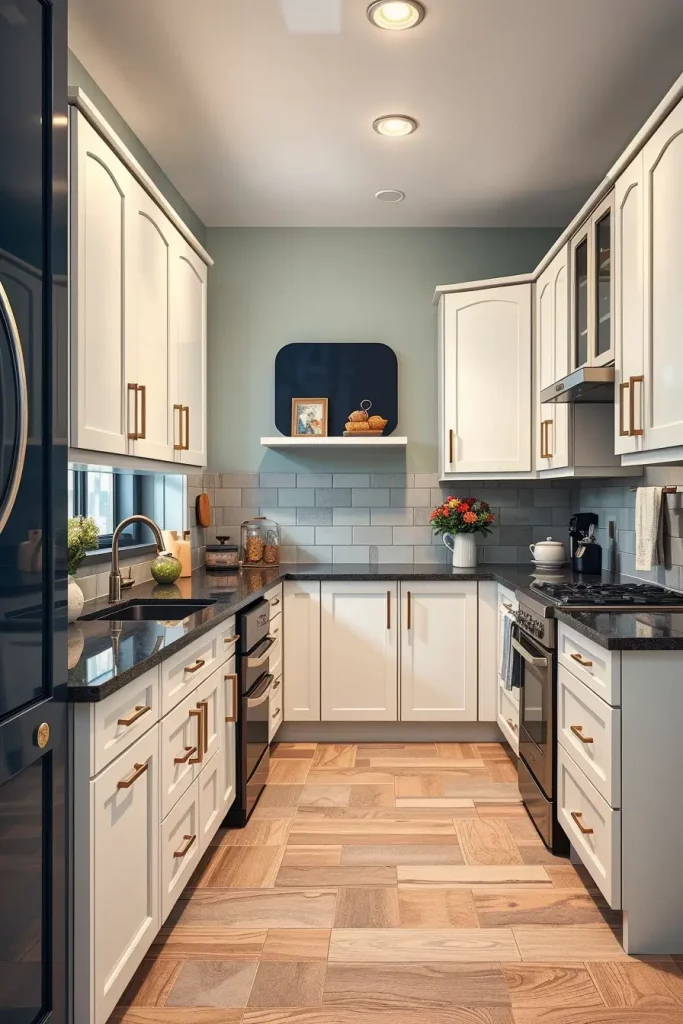
Color blocking is best combined with an open concept layout where walls cannot be used to provide borders. According to House Beautiful, it does a marvelous job at “defining areas in a subtle yet stylish way,” which I wholeheartedly support.
Having bar stools of the color used on the cabinetry and appliances can effectively english block design stove top while filling the whole kitchen bringing back the blocked colors throughout.
Built-In Seating And Breakfast Nook Innovations
The integration of a built-in seating area or breakfast nook is, in my experience, one of the more stylish and practical upgrades that can be made to a contemporary kitchen. It goes hand in hand with homes that are designed with multifunctionality in mind. Cooks and kitchen users appreciate how a cozy nook enhances the kitchen’s functionality, allowing not just for cooking, but also for casual dining, enjoying coffee, or even working remotely. From my experience, this arrangement provides the best results in terms of space utilization in small or open-concept kitchens.
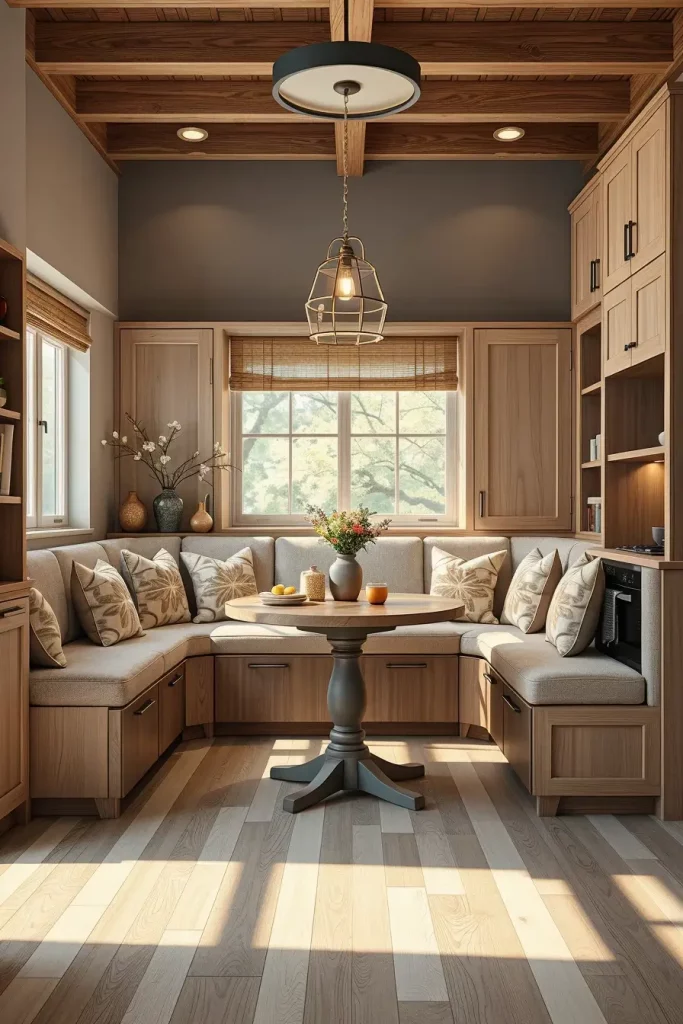
For built-in breakfast nook design, my preference is for L-shaped bench seating with concealed storage beneath the seat cushions. Most appropriate is a round pedestal table since it allows for greater movement around the space. The upholstery is soft and neutral, enhanced with geometric-patterned accent cushions that add comfort and a stylish edge. Being built-in, it guarantees perfect integration with surrounding cabinetry or island furniture.
Nooks do tend to soften the harder aspects of a kitchen and this is something I personally love. Architectural Digest notes that many designers suggest placing pendant fixtures for lighting on the table to provide warmth and intimacy. This visually encloses the nook while still keeping the area open.
To make this section better, I would incorporate custom seating millwork, like flanking side shelves or low bookcases for decorative cookbooks. Sconces mounted to the wall could also add to the lighting without taking away from table real estate.
Handleless Cabinets For a Seamless Look
One of the most standout characteristics of handleless cabinetry is how sleek and modern it looks. I must say, it has been a part of several of my clients’ remodels because it is simply stunning and appealing to look at. With no pulls or knobs, the cabinet envelops the surfaces completely, giving off a smooth, uncluttered atmosphere. This works best with flat panel cabinet doors which are primarily sounted from lacquered MDF or veneered wood.
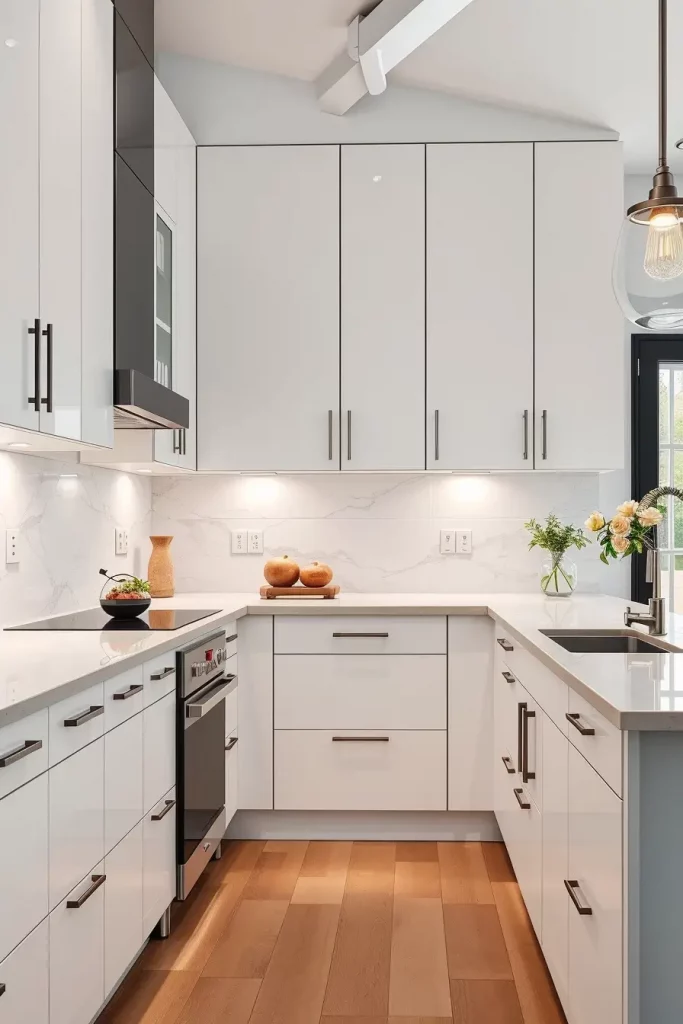
Best practices include the addition of push-to-open mechanisms, or recessed edge pulls, which I prefer to use. Matte white, charcoal, or wood grain finishes also add to the uncluttered aesthetic while still remaining useful. I usually pair these with quartz countertops, and a continuous backsplash which maintains the seamless transition of surfaces throughout the kitchen.
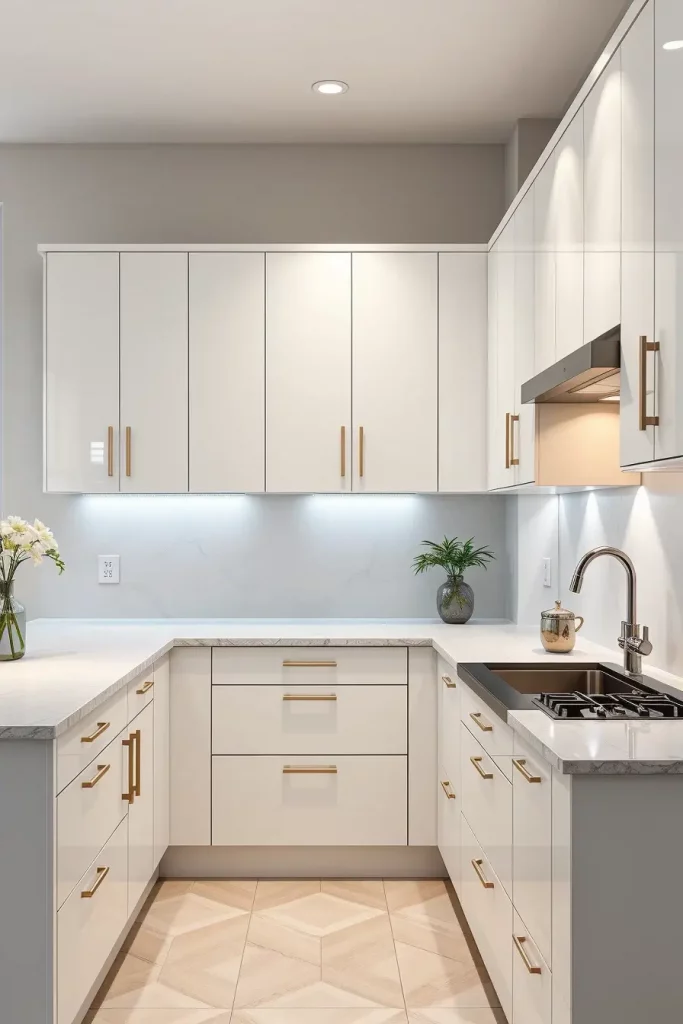
With my expertise, this option automatically optimizes the place and makes it easier to maintain. The Spruce recommends having soft-close add-ons in these types of systems for the utmost comfort when closing them as a luxury feature. Homeowners who want hands-off yet dramatic elements love this mix of innovation and style.
If anything can be added here, I’d remark that integrating under-cabinet LED strip lighting further enhances practicality by lighting up the countertop while still maintaining the cabinet’s sleek look.
Striking Back Backsplash Designs For Contemporary Chic
Backsplashes provide a wonderful chance to add custom flair to any kitchen, and I always suggest bold choices here. Striking backsplashes are useful for visually anchoring the space, especially in kitchens with neutral cabinetry or monotone themes. My go-to materials are full-slab marble, geometric ceramic tiles, or even mirrored glass for added depth and shimmer.

One of my go to designs is a vertically stacked glossy tile that goes from the countertop to the ceiling. This not only provides a stunning visual but also amplifies the height perception of the room. For contemporary chic, I love to pair black grout with white tiles or use a metallic finished tile for modern elegance.
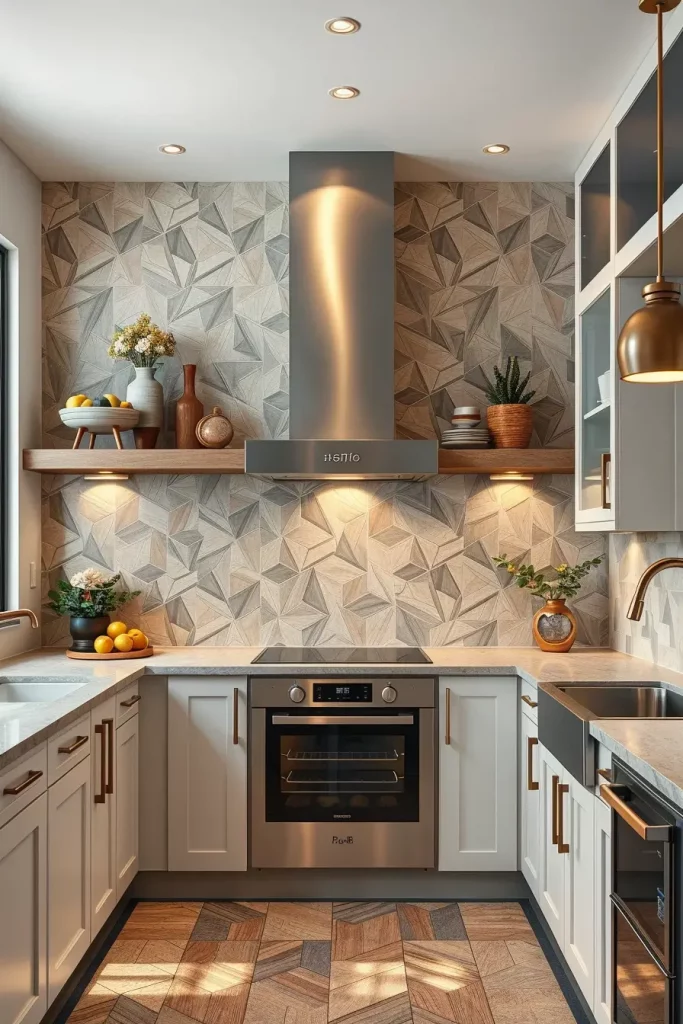
In my own work, bold backsplash designs have become the center of attention in my client’s houses. Elle Decor recommends bold colors or patterns as a counterbalance to minimalist cabinetry. It’s a clever means to achieve personal expression in a streamlined design.
For this area, I would add racks or glass floating shelves above the backsplash where cookbooks, plants, or other kitchen display pieces that fit within the overall style could be placed.
Striking Modern Kitchen Floor Designs
For contemporary kitchen spaces, achieving visual flow and withstanding wear and tear are two critical components for me, which guides my selection of kitchen flooring. My personal preference is large-format porcelain tiles and wood-engineered planks that mimic real timber. For the materials’ upkeep, these surfaces are moisture-resistant—and we all know that’s a non-negotiable in any kitchen—easy to maintain, and certainly brings an aesthetic appeal.
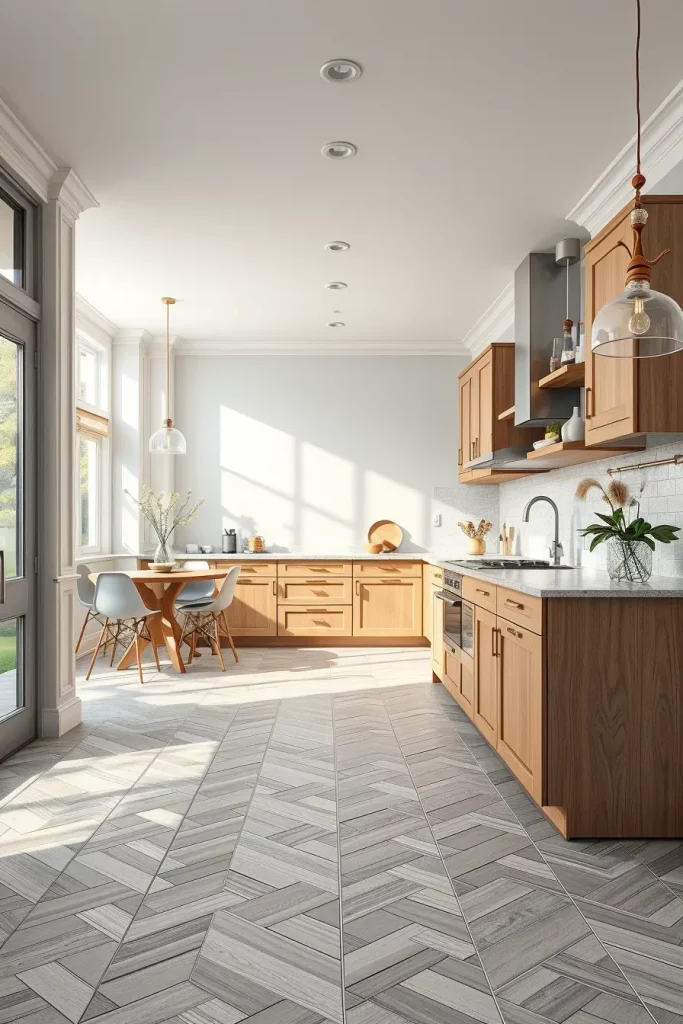
Of late, I have been using light gray stone-look porcelain tiles in open spaces and matte finish oak planks in more closed areas. These options also have great light reflectivity and neutral base for bold cabinetry and accentuated selections for countertops and backsplashes. Flooring designs with herringbone and chevron add some drama while not outdoing the rest of the room.
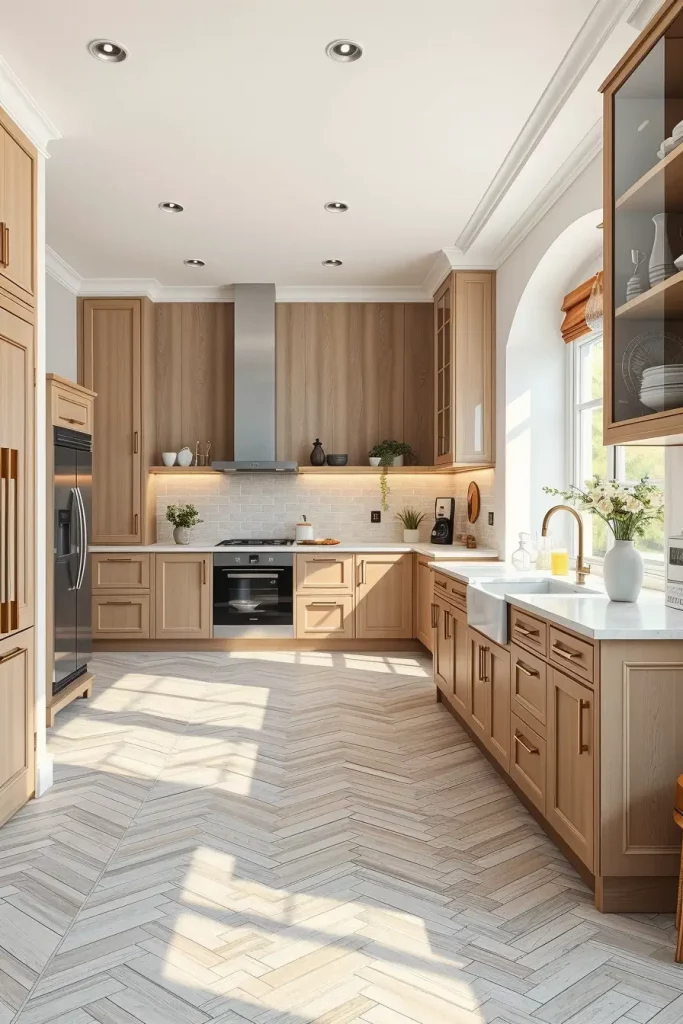
In a broader context, design is often in the background, yet powerful at the same time. As stated by Better Homes & Gardens, a good floor brings all areas of the kitchen together and changes the perception of space within it. I recommend taking samples of the flooring to the actual kitchen for the light before making the choice, and the final choice.
Something I would add is heating underneath tile or engineered wood flooring. This provides additional comfort and warmth, which is highly valued these days, and it complements the modern concern for aesthetics and practicality.
Energy-Friendly Appliances For Eco-Friendly Living
Choosing energy-efficient appliances is an equally important element of contemporary kitchen design because it helps achieve the goals associated with eco-friendly living. When designing kitchens, I focus on making everything with eco-friendly refrigerators, dishwashers, and cooktops—induction ones, in particular, as they look more modern. With these appliances, we can lower energy costs and promote a greener home, which is now a common demand among clients.
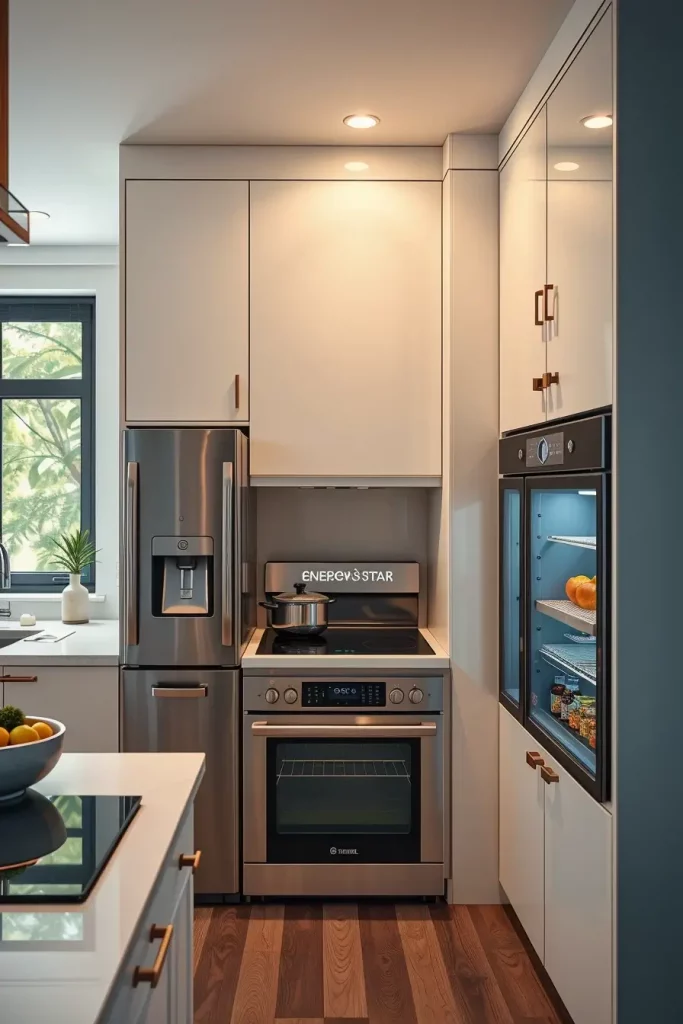
Take, for instance, the built-in, counter-depth refrigerators that I specify. They are uniquely designed, so they do not take up a lot of kitchen space, and their performance is top of the line. Another great feature is induction cooktops. It is safe and economical, and modern ovens come with separate air frying and steam cooking modes. All these aid in the establishment of a high-tech green kitchen.
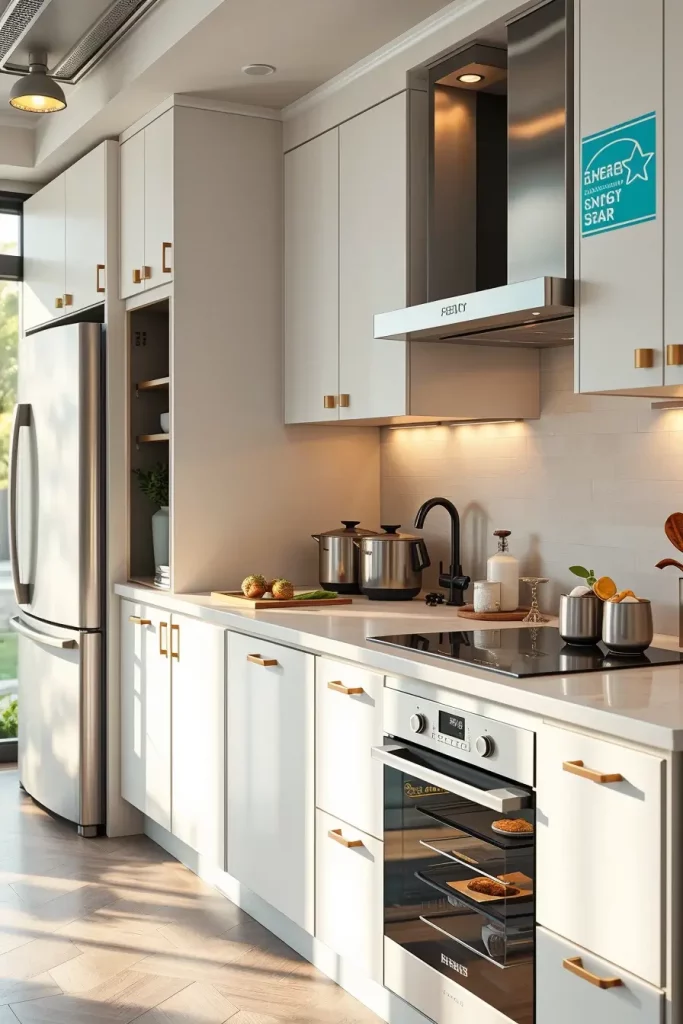
These appliances make life easier on a daily basis, and, from my own experience, electricity bills are significantly lower. In fact, the U.S. Department of Energy claims that upgrading to energy-efficient appliances allows households to save hundreds each year. That greatly increases the value of the property, and the expenditure is well justified.
That said, I would add an easy-to-use pull-out composting system and a recycling center integrated into the cabinetry for eco-friendly living. These small tweaks can make a positive difference towards promoting sustainable habits.
Layered Lighting Strategies For Functional Elegance
In a modern kitchen, lighting serves a dual purpose—it provides illumination while also setting the mood. I always employ a layered approach which includes task, ambient, and accent lights. This consideration allows the kitchen to function seamlessly during prep and flow effortlessly during evening gatherings.
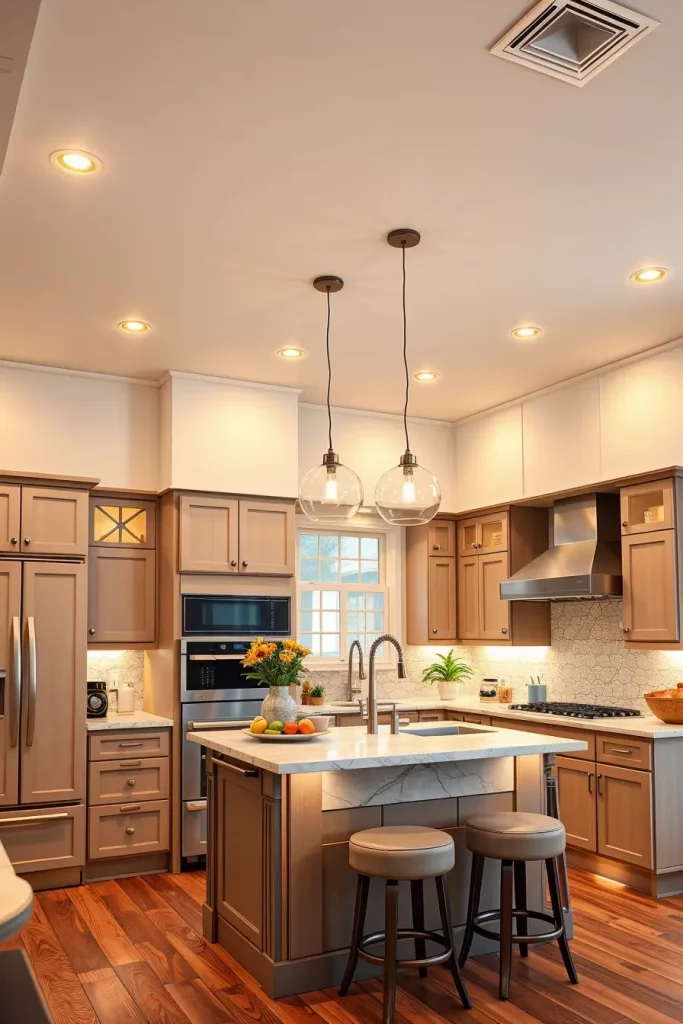
In my designs, I use LED recessed ceiling lights for general illumination and under-cabinet lights for tasks. Pendant lights over islands and breakfast bars provide visual interest too. The ability of adjustable lighting controls and dimmer switches to create flexible atmospheres from bright to cozy is unparalleled. With the versatile switching, cooking can be done under well-lit sessions, while dinners can be enjoyed in cozy dimmed settings.
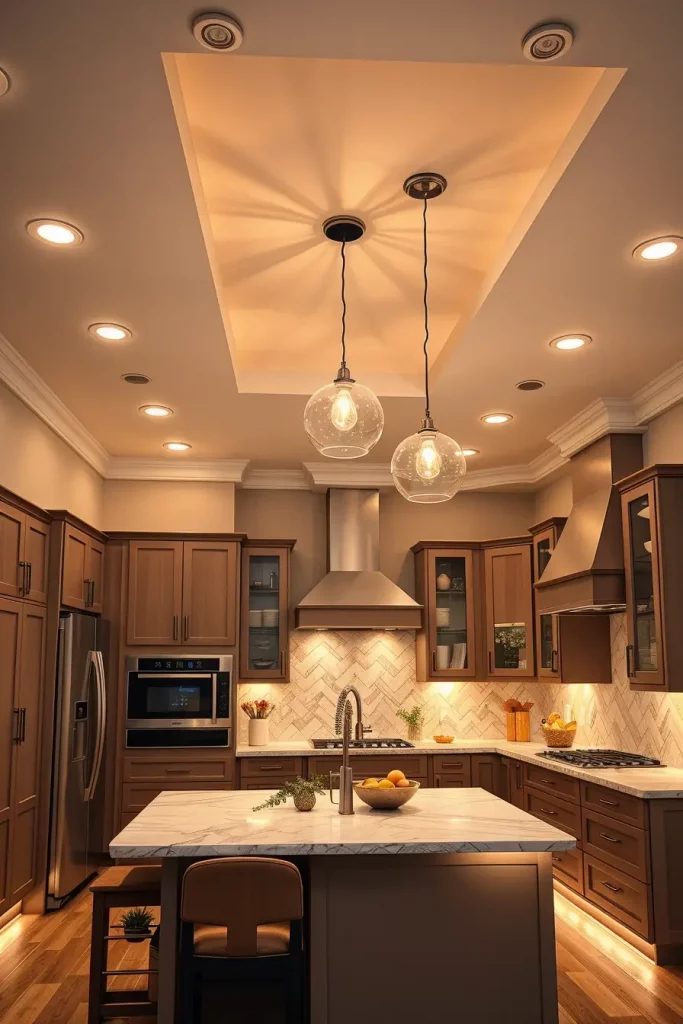
One tip I’ve followed is given by interior designer Nate Berkus, who suggests the application of warm white light in kitchens to make sure the place isn’t too clinical. That’s something I’ve tried in most of my projects because it tends to offset contemporary frostiness with a welcoming touch.
If I were to refine this concept, it would be adding toe-kick lighting that sits under the lower cabinetry. It adds to the aesthetic of the architecture but makes moving around at night easier.
How To Use Black Accent Pieces In Kitchen Design
Black accents are a great addition to contemporary kitchen décor. They offer definition and contrast while sharp matte black accents are an island, light fixtures, and even sinks. Matte black hardware, faucets along with an entire island black will draw eyes and create stunning focal points. Black works with virtually every color scheme, and adds a touch of class without overpowering the design.
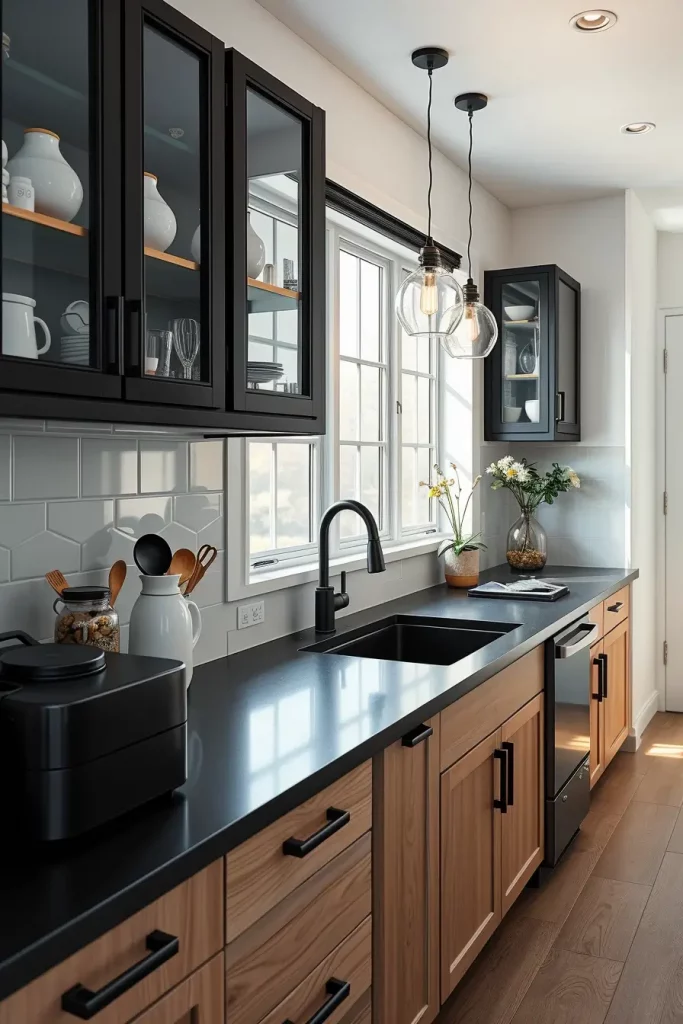
In one of my recent remodels, I used glass framed open upper cabinets with hand raws finished black to natural oak lowers. The combination gave the area structural contrast while still making the area feel spacious. Small details such as black door pulls or charcoal colored sinks go a long way.
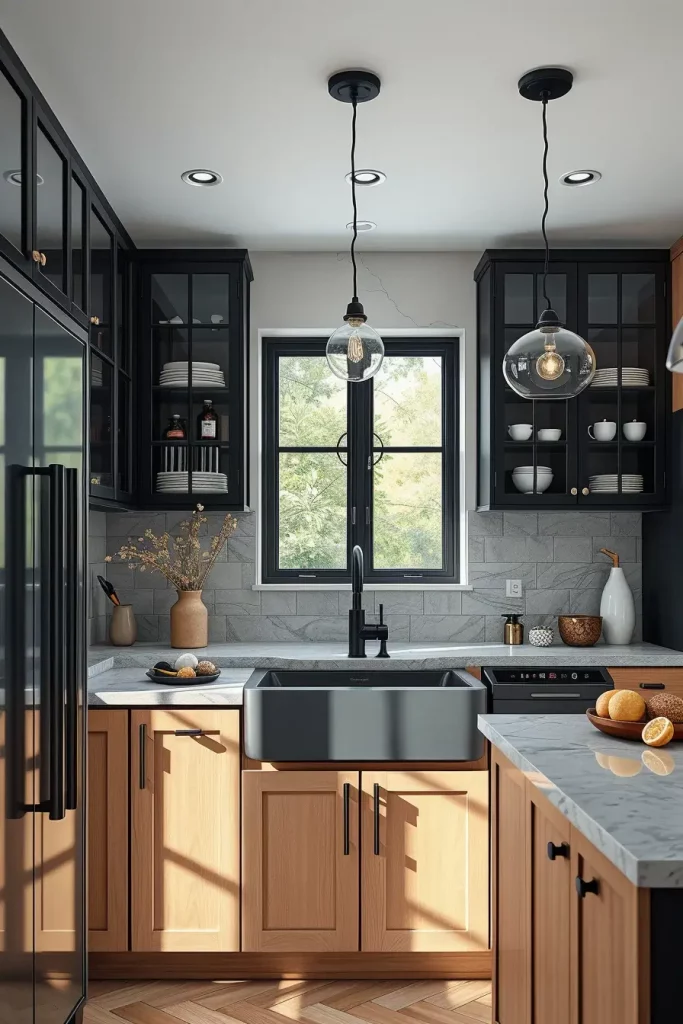
Myself, I find black accents to be very flexible. House Beautiful suggests the strategy of using black in small dielers as best black’s versatility ensures timeless beauty and trend forward design without dimming the aura of the space. I always return to this strategy for clients who are after timeless yet trendy looks.
As for this strategy, I would prefer a black accent wall or a stained black wood ceiling beam to frame and tie everything which would add to the theme while also improve architectural interest.
Two-Tone Cabinet Designs For Depth And Contrast
In my opinion, adding personality—and depth visually—using dual-tone cabinets in contemporary kitchens is one of the most effective strategies. This provides a special area, color zoning, or area highlighting through the use of color; working with colors is always intentional. This design principle contains balance, such as the ones with darker shades like navy for the lowers and white for the uppers to keep the kitchen grounded while making the space above feel lighter.

Add some visual uniformity by utilizing matte finish cabinetry on the bottom half and glossy or natural wood finishes to the top. Functionally, open shelving over dark base cabinets can improve lighter feel. Bring the two tones together with cohesive hardware finishes such as brushed brass or matte black where the finishes remain unified.
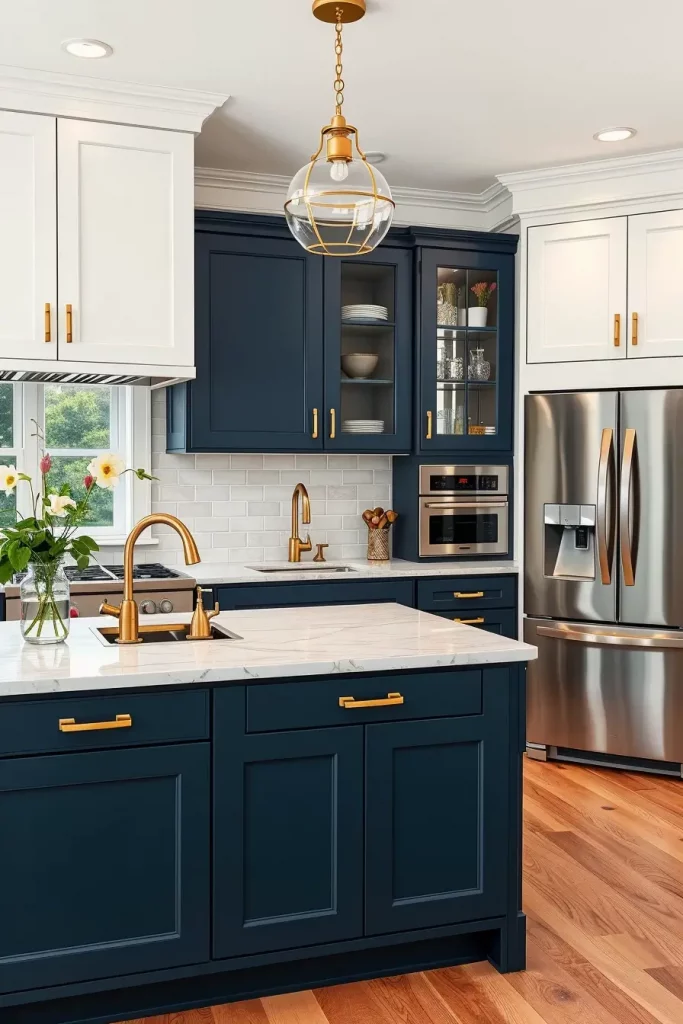
Balanced character is why on a personal level I appreciate this design strategy, supporting comments from HGTV designers who recommend warmer woods paired with muted colors for a more modern leaning transitional style. The timeless but up-to-date modern aesthetic is what I want to achieve in homes while applying design this way.
To improve this strategy, I would place a central island in a third accent color of the design like deep forest green or charcoal grey to balance the layout and add an eye-catching element.
How to Achieve the Best Use of Daylight in Kitchen Design
A well-lit kitchen is one of the most inviting and functional elements in modern kitchen design. Optimizing natural light provides an uplift, great atmosphere along with ease on the eyes, and increases overall well-being. For best effect, I always try to place the sink or prep space adjacent to a large window and keep window coverings to a minimum to maximize light.
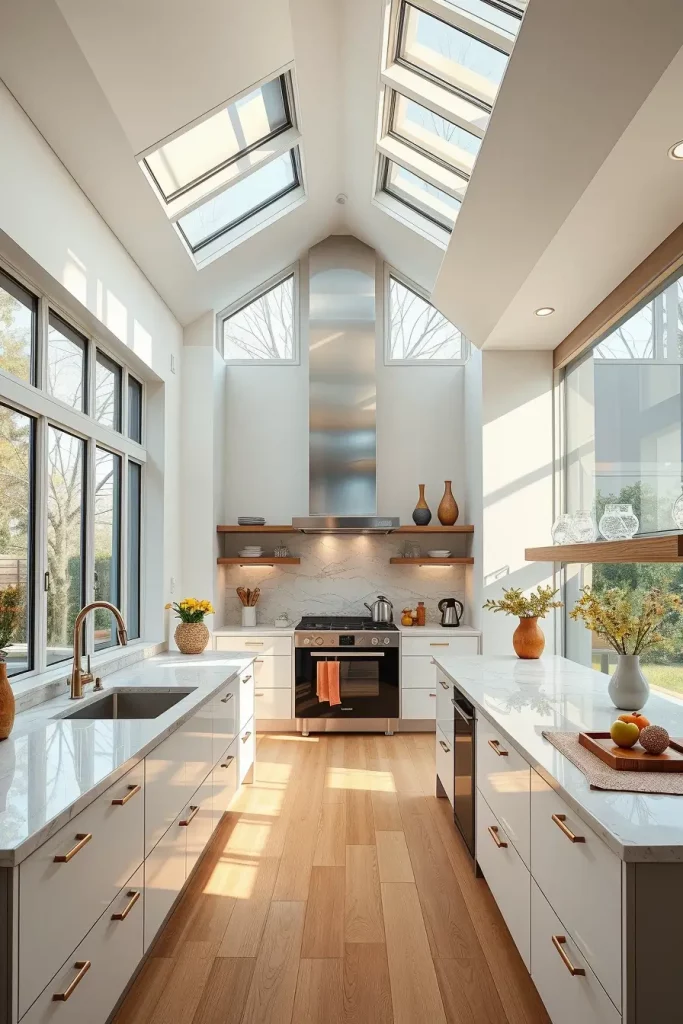
In recent remodels, I’ve installed full height glass sliding doors opening to a deck or backyard. I find these help create a smooth flow between inside and outside. Also, skylights and clerestory windows are excellent at providing illumination without taking away wall space. Walls that are finished with light colors, glass tiles and even the cabinetry add to the brightness of the space while increasing the illusion of the available space.
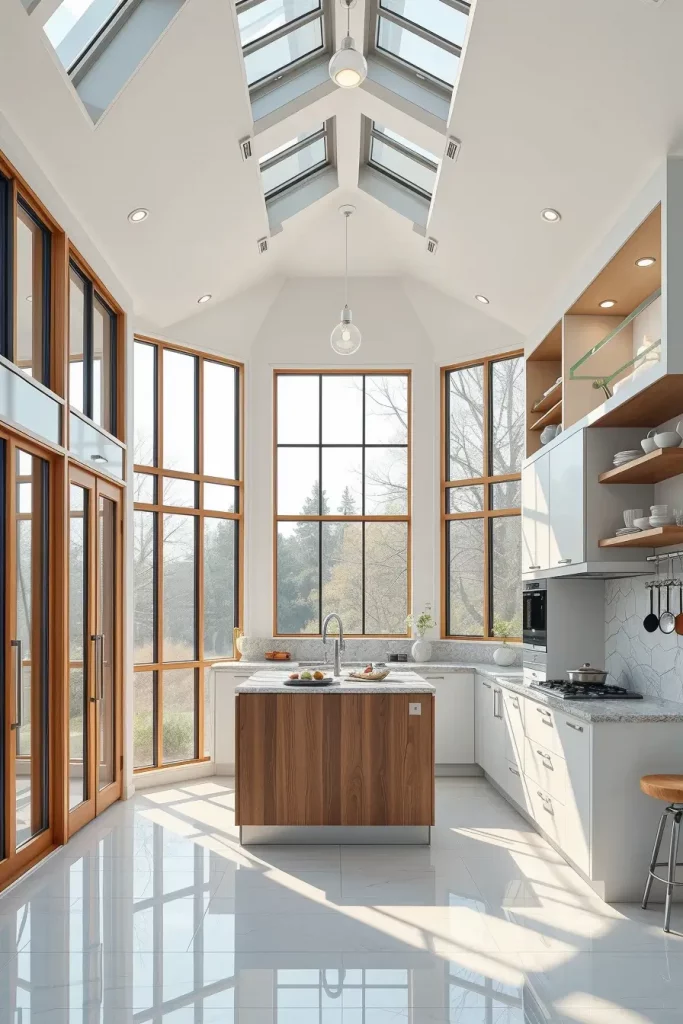
From my experience, having a substantial amount of natural windows makes the kitchen more vibrant, increasing the energy in the air. Dwell states that the presence of sunlight always provides a more contemporary and emotionally appealing atmosphere to the space. I always make sure that the layouts I design pay off the consideration to enhance window placement and resort to remodeling windows that would alter the layout if need be.
The strategic use of mirrors or glossy backsplashes to reflect sunlight deeper into the room is often overlooked. I would definitely recommend these techniques to darker or narrower spaces.
Functional Kitchen Layouts For Contemporary Homes
Of great importance in contemporary kitchens is the layout. The work triangle, comprised of the sink, stove, and refrigerator, forms the basis of movement in my designs. For the available space, I choose from galley, U-shape, L-shape, and open layouts to balance function with flow. It is not only about aesthetics. It is about how well the kitchen serves its users.
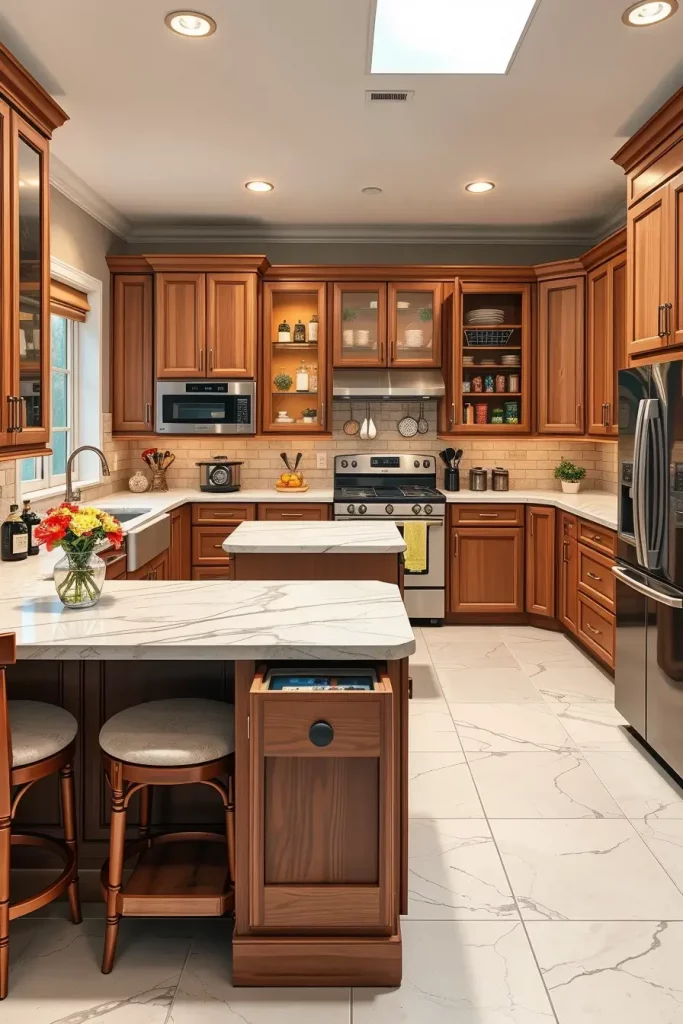
I like adding islands to increase counter space, which allows for interaction during food prep. Walkways need to be a minimum of 42 inches wide in busy households. For taming clutter and providing easy access, pantry storage in tall cabinets and cookware in drawer systems are ideal. Defined zones for prep, cooking, and clean-up are non-negotiable.
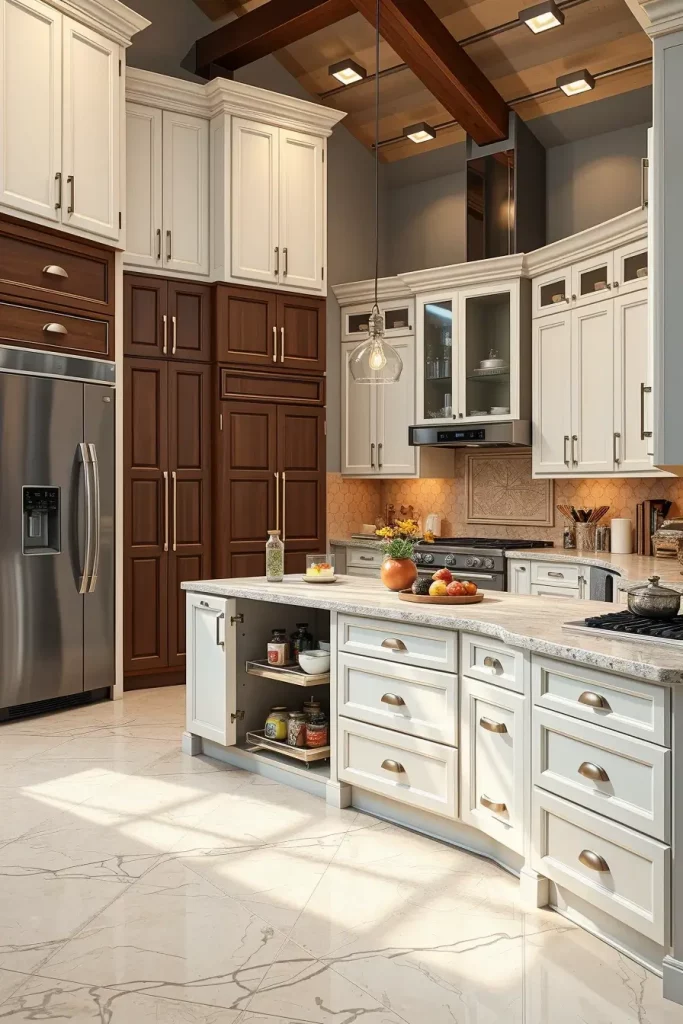
In my experience, the best designs are those that are seamless. Practicality-enhancing details like charging stations and pull-out trash, as noted by This Old House, do not detract from the beauty of the design. I’ve witnessed how satisfying this approach is for clients.
Consider an optional spice pull-out cabinet, as these help streamline the workflow within the kitchen. They often go forgotten in initial plans which is why an integrated appliance garage could be useful too.
Metallic Accents And Finishes For Luxe Appeal
I have clients that have expressed wanting to balance out the modern look of their kitchens with a hint of glamor, so I recommend integrating metallic accents into the design. These touches bring life to the composition and provide additional depth and illumination. Consider the use of brushed gold handles, bronze light fixings or even the more common stainless steel faucets which not only enhance modern appeal but retains the luxury of the room as well.
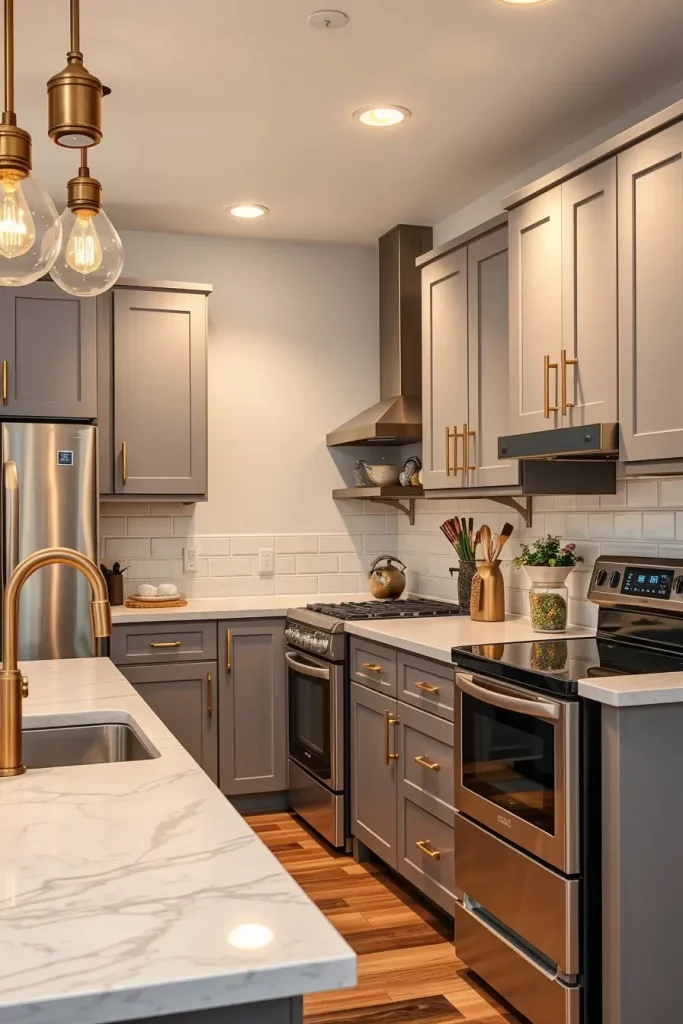
With larger spaces, I tend to lean towards the subtle use of metallics, allowing them shine the most when incorporated into the space. Some of my go to combinations include brass cabinet pulls with a muted grey island or stainless steel appliances against matte black cabinets. In kitchens that feature a warm-toned palette, copper range hoods or even gold sink fittings sink beautifully.
In my own experience, I view metallics as the jewels of the kitchen, bringing out the elegance of the layout while capturing the attention of guests. Keeping in mind what is said in Elle Decor though, the danger lies in straying from the core idea—too many finishes can result in visual chaos. That’s why I prefer to maintain balance using no more than two contrasting finishes per kitchen.
One thing I would suggest to this idea is incorporating metal in places such as a toe-kick or open shelf brackets. These places can be surprisingly pleasant while being cohesive at the same time.
Integrated Kitchen And Dining Spaces
In modern-day houses, the kitchen and dining areas no longer exist as standalone zones. To promote a more sociable and flexible lifestyle, I frequently design integrated kitchen and dining spaces. Removing barriers such as walls and raised countertops makes the transition from cooking to dining effortless.
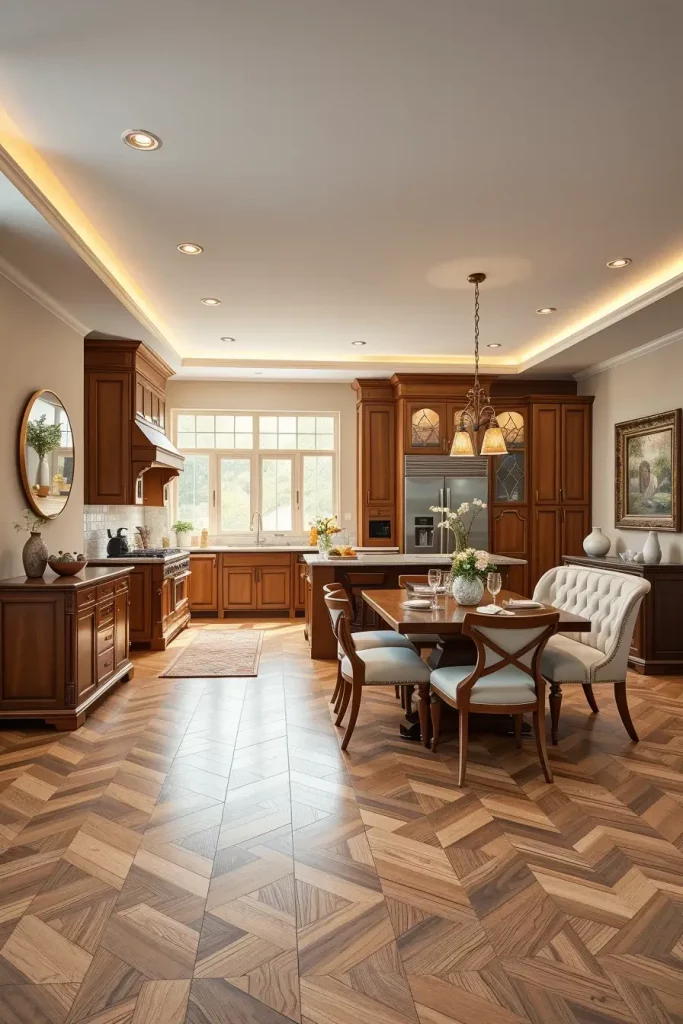
A coherent design philosophy reinforces the relationship among the areas. It is my practice to apply the same flooring throughout both zones and also extend the cabinetry color to the built-in or dining furniture. Another one of my favorite tricks is the bench seating that runs from the kitchen into the dining room. Also, pendant lights or sculptural chandeliers over the dining table give architectural distinction while still keeping the space open.
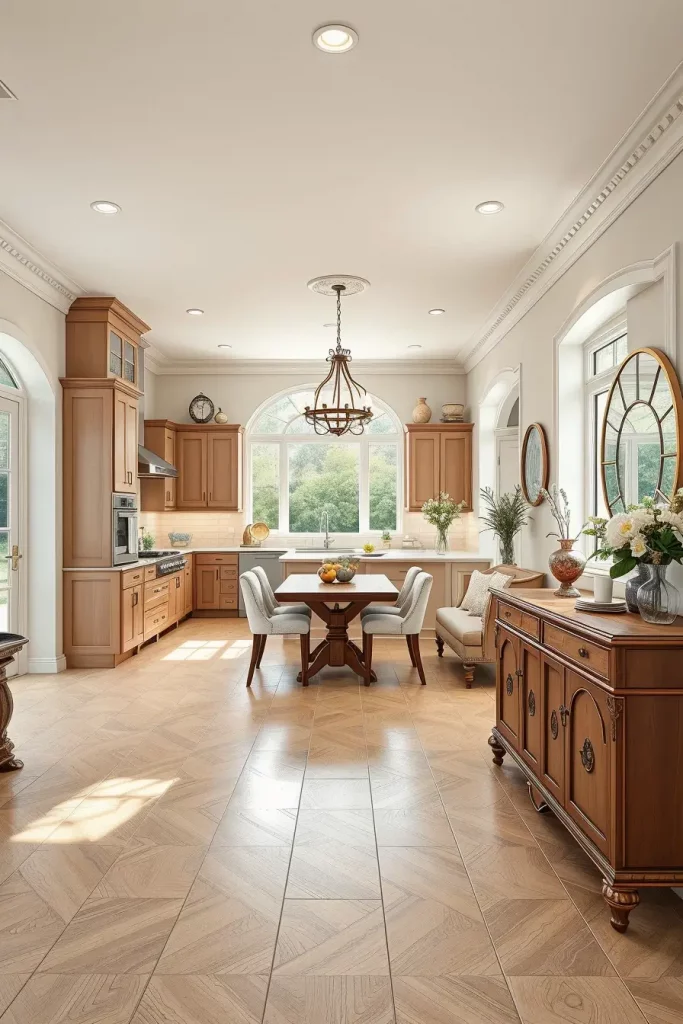
For my own works, I’ve noticed these open areas help promote socialization and a stronger connection with guests or family. As reported by architectural digest, integrated layouts are their favorite, stating these layouts are best for entertaining guests and maximizing space within a home’s urban setting.
To build on this, I would recommend a custom banquet or sideboard straddling both zones which would enhance storage while providing stylistic balance.
Geometric Forms And Lines In Kitchen Design
Adding geometry to a contemporary kitchen brings a powerful order to the space. The overall design harmony and progression of a kitchen, like any other modern structure, comes from clean lines, angular shapes, and repetition. Architectural rhythm is something I like to reinforce using hexagonal tiles, slatted wood panels, or even linear light fixtures.
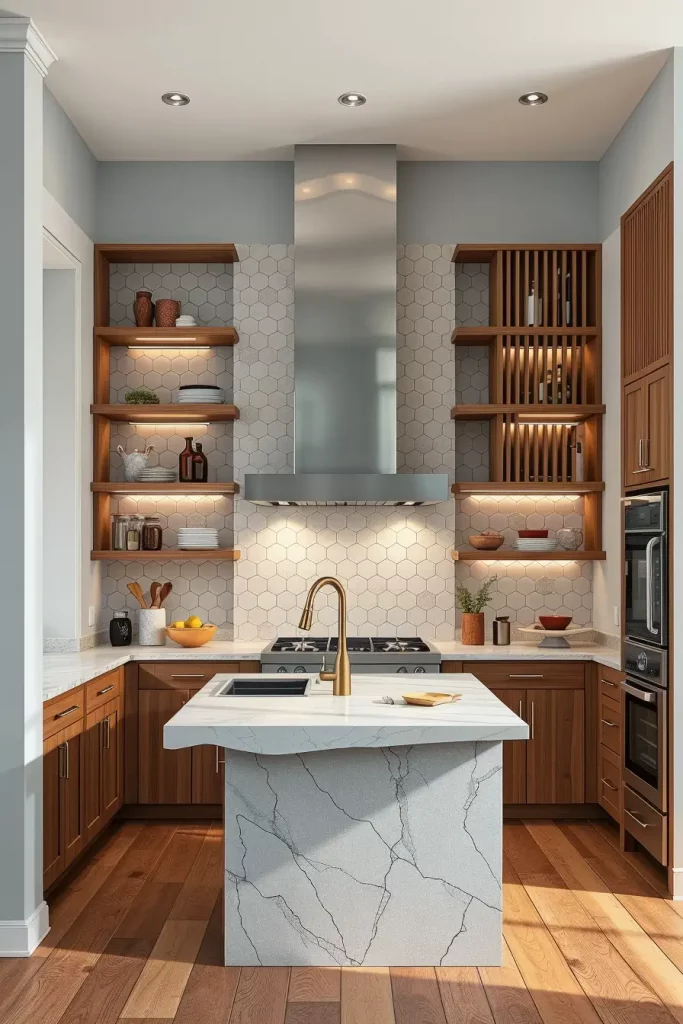
I always go for strong horizontal grain patterns on the cabinetry and open shelving set up in order, as well as isles form with waterfall countertops emphasizing the shape. Interest is added with structure by using geometric pendants and backsplashes with diamond shapes.
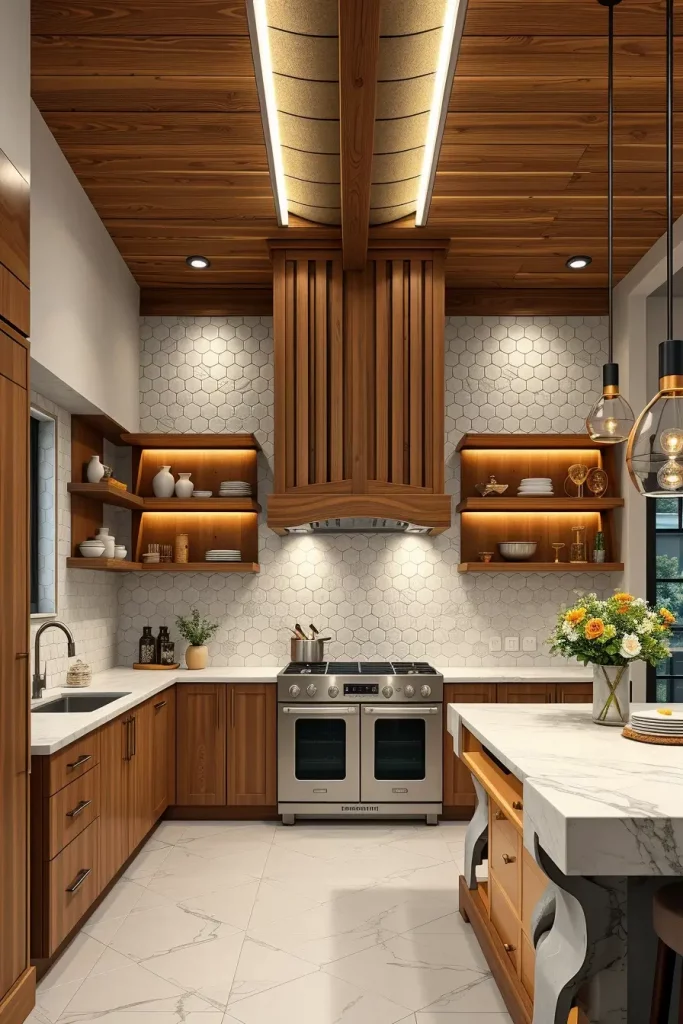
For me geometry is a way to create balance. It’s not about crowding the area; it’s guiding focus and framing the layout. As Domino notes, there is currently a boom in geometric features because they provide sophistication with simplicity. In my experience these shapes can always be relied upon as a visual guide to connect disparate parts of the kitchen.
Acoustic decor panels with geometric patterns would improve noise and echo control, especially in open space designs.
Scandinavian Influences In Contemporary Kitchens
If I want to bring warmth, simplicity, and functionality into a modern kitchen, I often look to Scandinavian design. This style focuses on minimalism, natural materials, and light color palettes. It adds a lived-in quality to sleek spaces and aligns effortlessly with contemporary design principles.
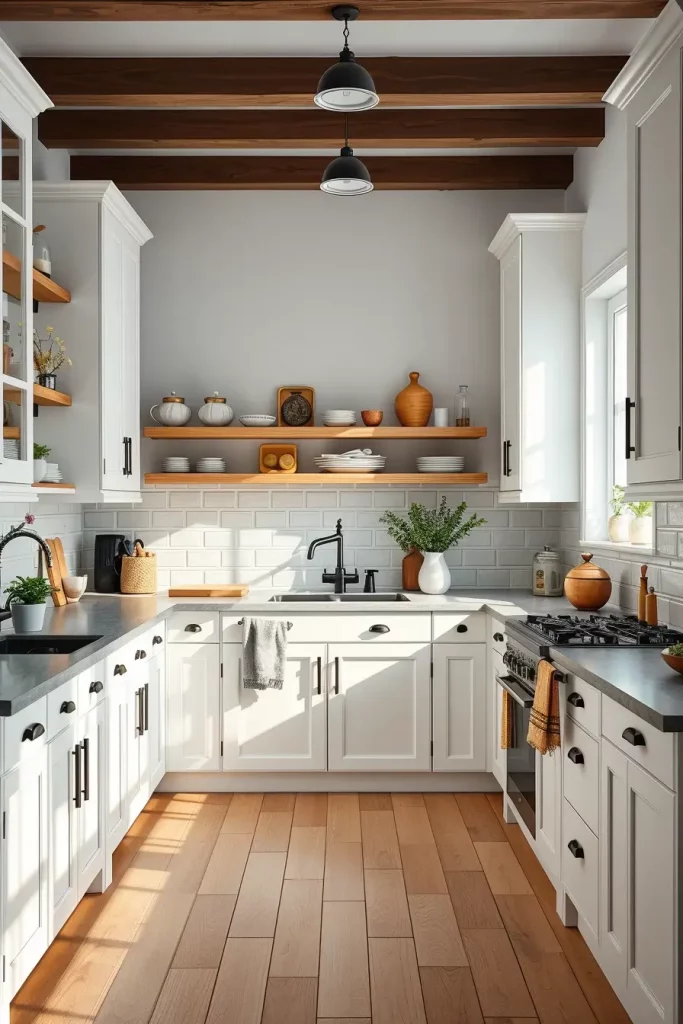
Some of my favorites are soft grey or white cabinetry, open shelving, large windows that amplify natural light, and pale wood floors. To add contrast, I like adding matte black or stainless fixtures and using linen curtains and felt pendant lamps for added texture. Clutter-free countertops and minimalist hardware are essential.
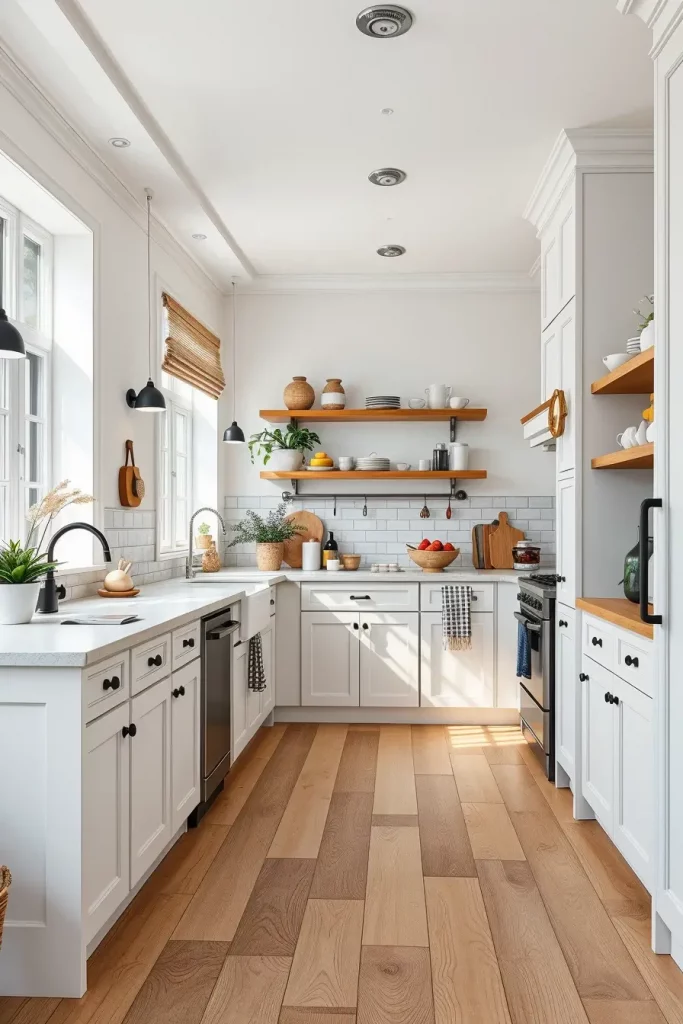
In my opinion Scandinavian design promotes calm and ease. In the same article from House & Garden UK, their main focus was ‘quality over everything.’ There should be fewer but better items, which is what I aim to do with every Scandinavian inspired kitchen I design.
To enhance sustainability without losing style, I’d add eco-friendly features such as recycled stone countertops or bamboo utensils.
The Rise Of Compact And Modular Kitchen Design
With urbanization growing rapidly, I have come to appreciate and observe that modular kitchens are now at the forefront of modern design. The practicality and versatility of compact culinary spaces work equally well in apartments as well as larger open-plan areas. This method is centered around clean lines, smooth and polished cabinetry, and effective storage solutions. Vertical space, sectioned zones, and pull-out drawers are commonly used to optimize every inch of space in these kitchens.
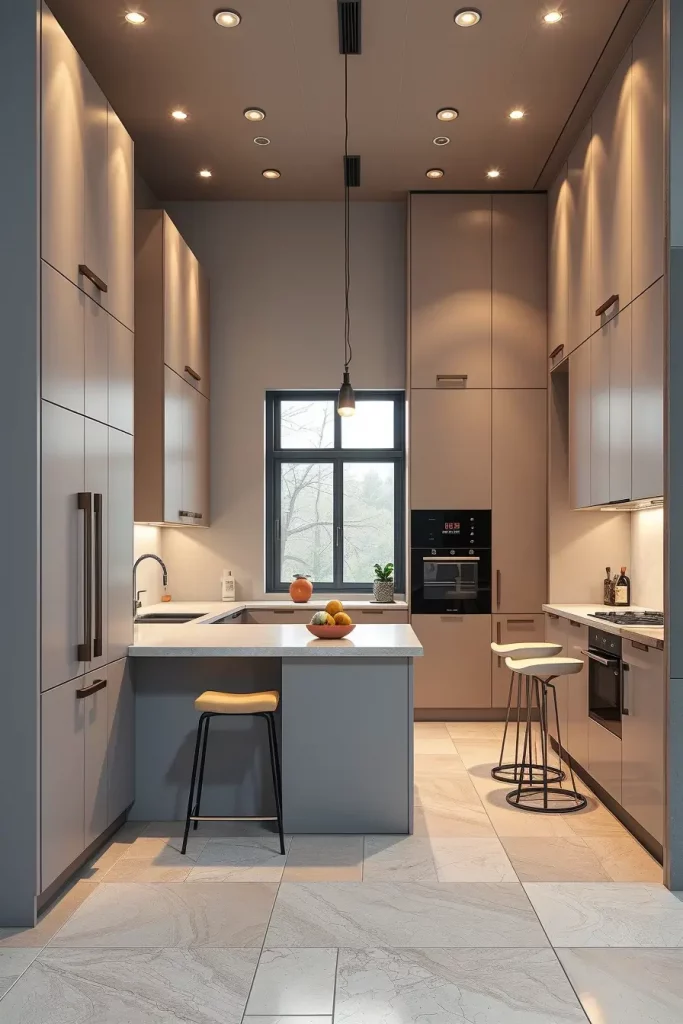
In all my designs, I incorporate rolled kitchen islands, corner drawers, and propelgistering Italie-reaching multi-purpose cabinets. Additional flexibility is provided My compact multi-purpose stools and narrow bar tables. Sophisticated materials such as laminated wood, matte lacquer, and even powder-coated metals are tri-factors to why modular kitchens offer ever-clean looks and durability. Furthermore, I always try to add soft-close mechanisms, integrated appliances, and other touches to enhance the look of the kitchen.
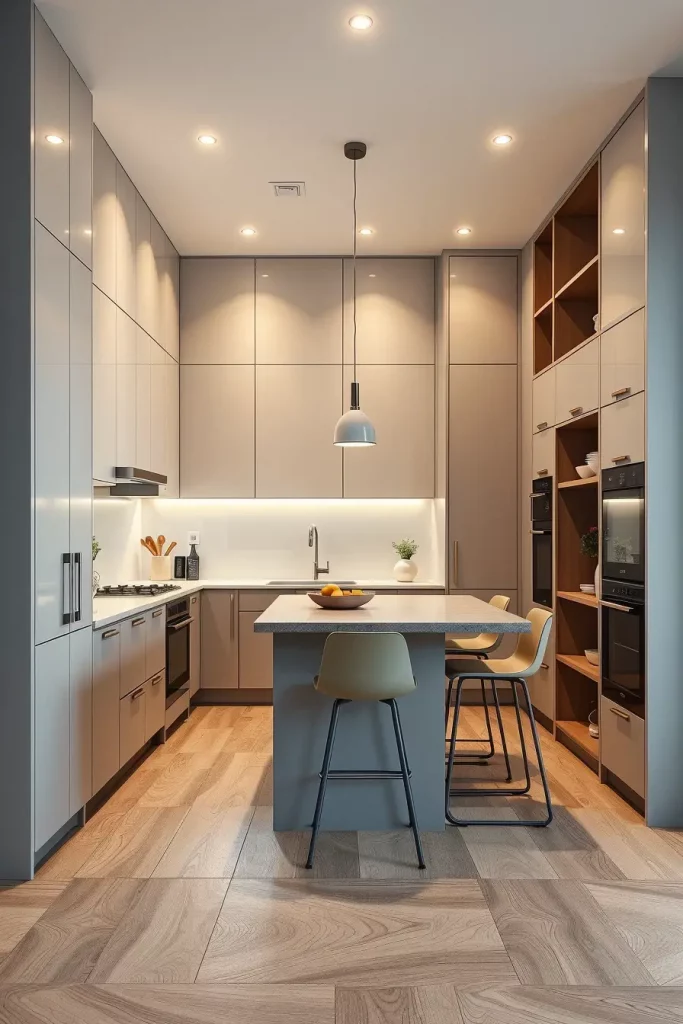
Modern American homes and other countries have also integrated this concept, especially those residing in urban homes in New York and San Francisco. Architectural Digest editors have also highlighted magnificent designs of modular kitchens blending beauty and inventiveness that stand up to stress-test ergonomics. These kitchens showcase the intriguing limitless potential for modern elegance that captivates countless designers and builders alike.
To further enhance this area, I would suggest adding open shelving made of tempered glass or natural wood for an airy appeal. Integrating a movable kitchen trolley is another suggestion, which adds flexbility and storage without sacrificing style.
Incorporating Glass Elements for a kitchen that feels Light and Airy
In my opinion, incorporating glass elements is one of the best ways to create an open feel in the kitchen. It can be done with glass cabinetry, backsplashes, or even glass doors that are paneled. These features not only add depth to the room, but also make it feel lighter, spacious and refined. Small kitchens will especially benefit from glass surfaces because the reflection of light creates an illusion of expanded volume.
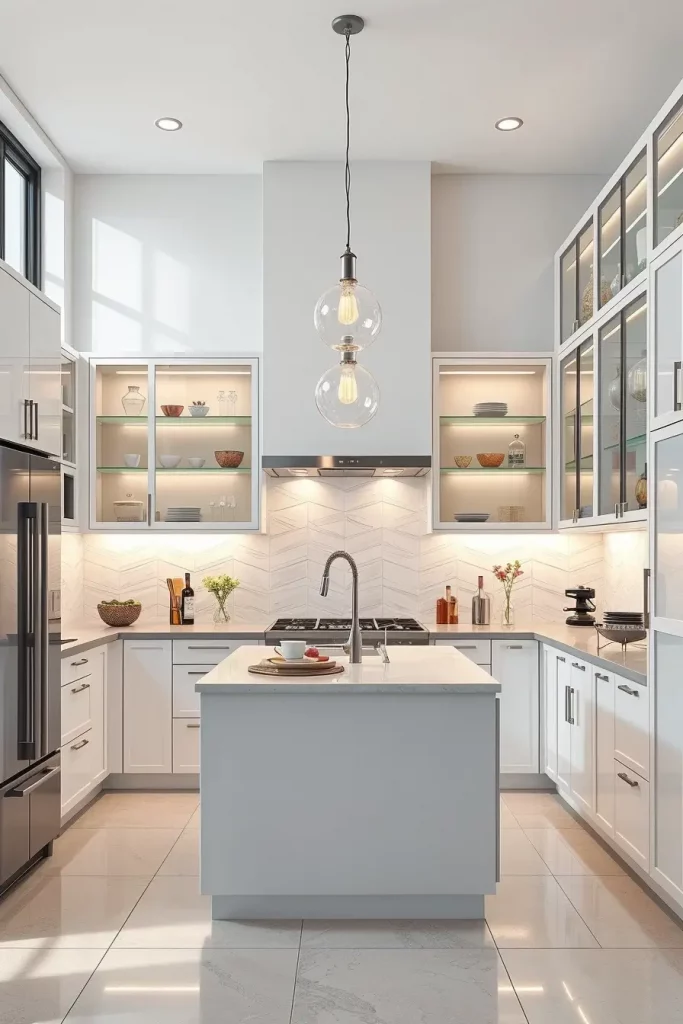
As for me, I love combining white, lower cabinets, and frosted glass upper ones. This design effectively balances and structures the kitchen, softening its visually-heavy elements. Another addition I like to include is a glass backsplash behind the induction cooktop, not only is it sleek, but it is also effortless to clean. There’s an added effect of clarity and elegance to the room with pendant glass lights over the island.
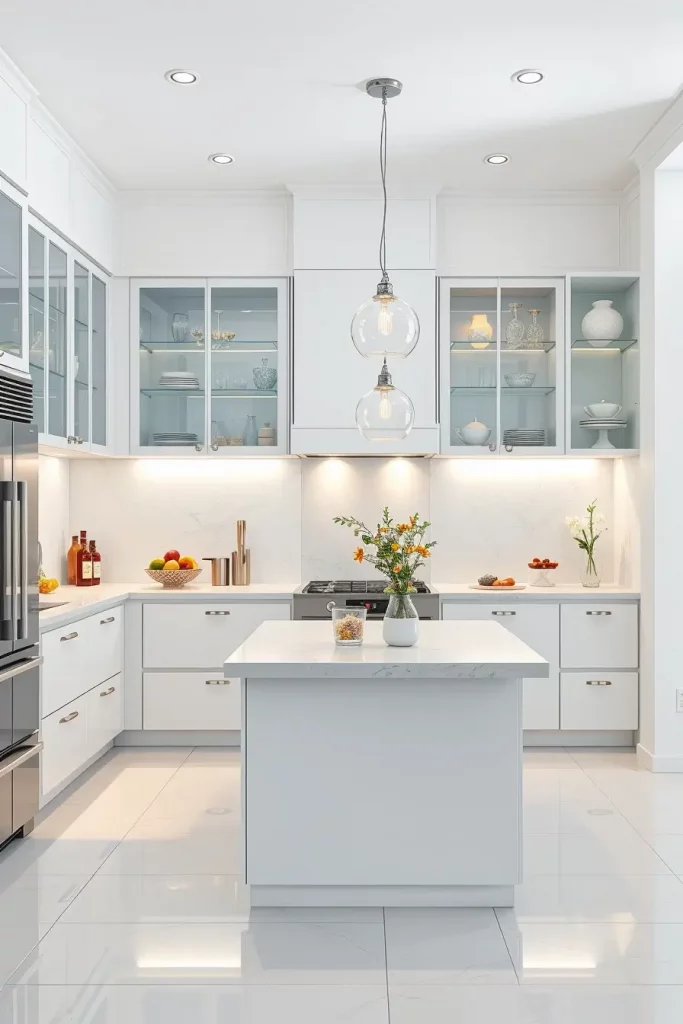
Not long ago, I worked on a kitchen project with a stunning glass wall partition that provided separation between the cooking area and dining space while maintaining the flow of light. This design was featured in one of the best kitchen layouts of the year for Elle Décor. Even simple kitchens can be enhanced to seem more expansive and elevated with these features.
To achieve an even more luxurious look, I would suggest adding LED strip lighting to the internal sections of the glass cabinets. It provides a sophisticated accent to the dinnerware while softening the overall look of the kitchen.
Convenient High-Tech Kitchen Features
Modern kitchens require advanced technology more than ever. The contemporary design of a kitchen demands everything from touchless faucets to smart ovens. Adding high-tech features has become part of design etiquette. These aspects are practical and effortlessly enhance the clean look characteristic to modern interiors. What I love the most is the fact that every element is getting more intuitive and efficient; cooking is becoming more pleasant on a daily basis.
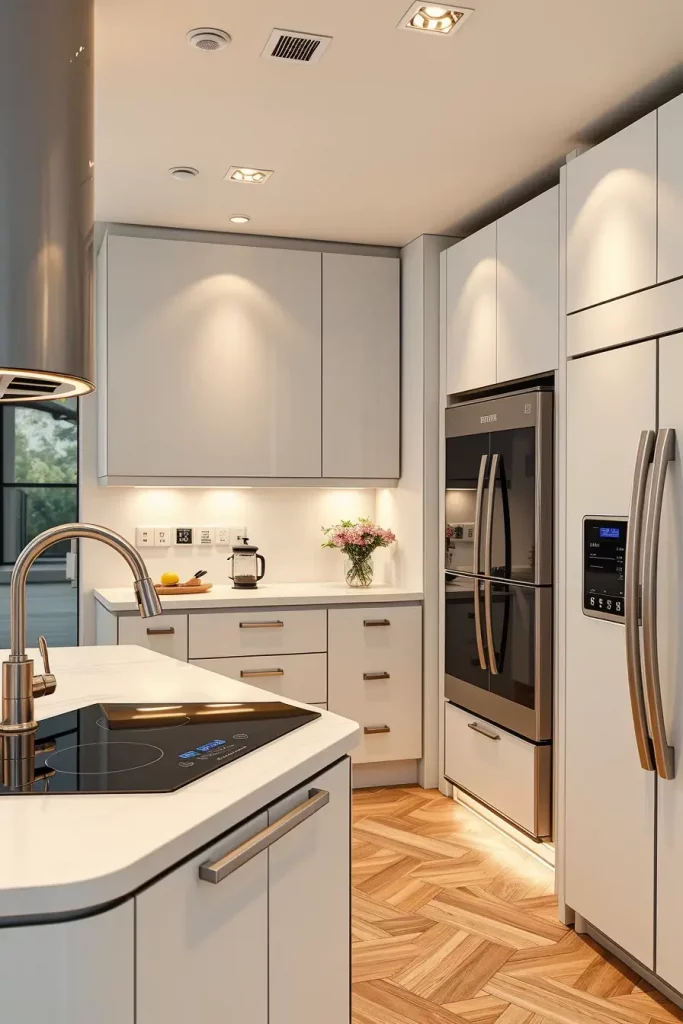
My most recent work includes appliances with Wi-Fi functionality, including camera refrigerators, sensor induction cooktops, and app-controlled wall ovens. Other staples include voice active lighting, motion sensitive faucets, and retractable outlets. The aesthetic is still streamlined because the control interfaces are covered with cabinet doors.
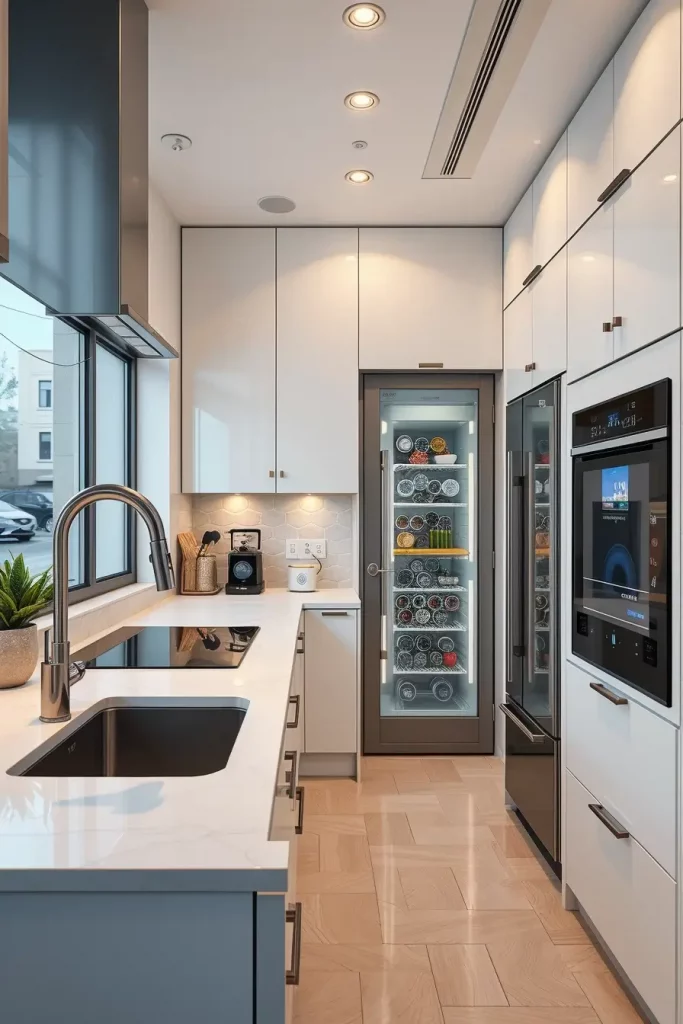
In one of the kitchens that I designed, there was an automated pantry with sliding shelves—menus like you see in restaurants where a simple touch opens bookshelf interfaces and everything is revealed. I remember these particular features from a House Beautiful column urging readers to purchase devices that improve the quality of life instead of those that serve as mere gadgets.
If I had to design one more feature here, it would be a smart lighting setup with gradual dimming so it would change with the time of day. Early mornings during routine would be soft warmer light, while preparing dinner would be bright calendar specific lighting.
Custom Features of Contemporary Kitchen Design
In custom modern kitchens it is no longer only about cooking, but also a reflection of identity. In my opinion, tailored modern kitchens showcase not just lifestyle, but taste, and the family’s daily schedule. From bespoke storage systems to eye-catching pops of decor, these details bring warmth and life to the space—even a modern one.
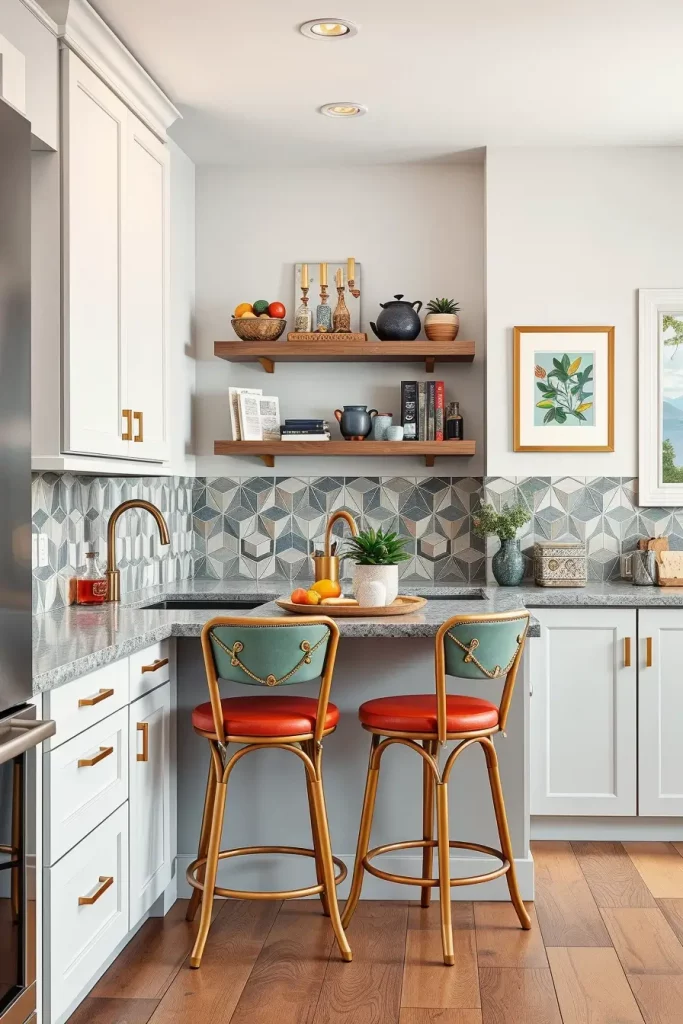
I recommend that customers select unique hardware finishes like brushed brass or matte black to add some of their personality. A bespoke coffee station, a dedicated spice rack, or even a nook bookshelf for cookbooks reveals a lot about a person’s daily habits. Daring geometric tile backsplash patterns, colorful bar stools, or even framed art over the sink may vibrantly express your touch and make the space feel uniquely yours.
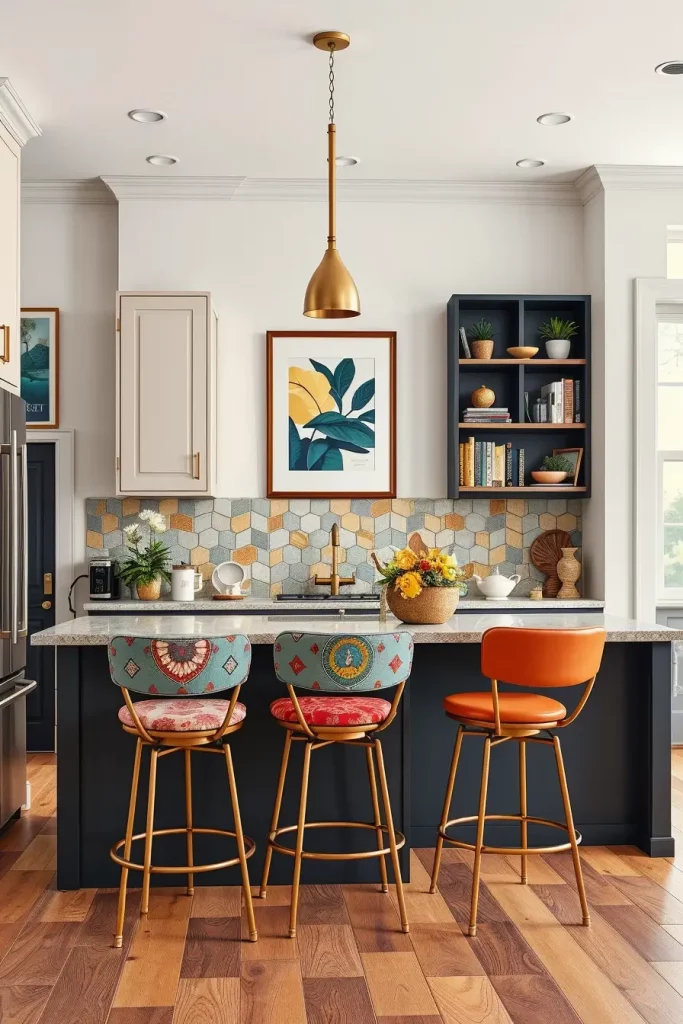
One of my favorite projects was for this family that decided to use vintage tiles from their grandmother’s home for the centerpiece backsplash wall—they blended beautifully with the new cabinet and lighting to create a stunning focal point. Dwell Magazine frequently highlights kitchens like this, which showcase style and personality, to dispel the notion that the two cannot coexist.
Following the same idea, I would incorporate a rotating shelf designed for seasonal or sentimental displays. This feature keeps the kitchen lively and serves as an inexpensive way to refresh the space without extensive renovations.
A modern kitchen design balances the captivating touch of modernity with practicality. Each integration like smart innovations and sleek surfaces serve their own purpose along with other innovations, creating a beauty that isn’t only skin deep. What innovations do you find the most inspiring? I look forward to reading your suggestions. Please leave your questions or suggestions in the comments.
